Bosch 4405 User Manual
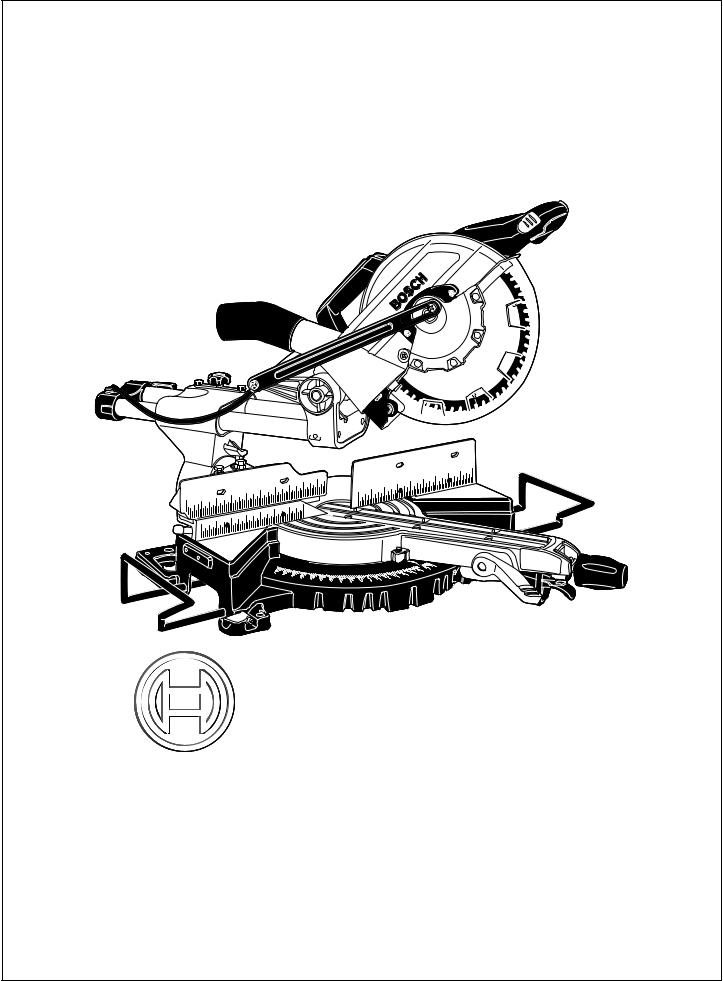
IMPORTANT: |
IMPORTANT : |
IMPORTANTE: |
Read Before Using |
Lire avant usage |
Leer antes de usar |
|
|
|
Operating/Safety Instructions Consignes de fonctionnement/sécurité
Instrucciones de funcionamiento y seguridad
4405
|
|
Call Toll Free for |
Pour obtenir des informations et |
Llame gratis para |
|
|
|
|
Consumer Information |
les adresses de nos centres de |
obtener información |
|
|
|
|
& Service Locations |
service après-vente, |
para el consumidor y |
|
|
|
|
|
appelez ce numéro gratuit |
ubicaciones de servicio |
|
|
|
|
|
|
|||
|
|
1-877-BOSCH99 (1-877-267-2499) www.boschtools.com |
|
|
||
|
|
|
|
|
|
|
|
|
|
|
|
|
|
|
|
For English Version |
Version française |
Versión en español |
|
|
|
|
See page 2 |
Voir page 78 |
Ver la página 42 |
|
|
|
|
|
|
|
|
|

Safety
! WARNING “READ ALL INSTRUCTIONS” — Failure to follow the SAFETY RULES identified by BULLET (●) symbol listed BELOW and other safety precautions, may result in serious personal injury.
General Safety Rules
For Bench Top Tools
Work Area
●Keep work area clean and well lit. Cluttered benches and dark areas invite accidents.
●Do not operate power tools in explosive atmospheres, such as in the presence of flammable liquids, gases or dust. Power tools create sparks which may ignite the dust or fumes.
●Keep bystanders, children and visitors away while operating a power tool. Distractions can cause you to lose control.
●Store idle tools out of reach of children and other untrained persons. Tools are dangerous in the hands of untrained users.
●Do not leave tool running unattended, turn power off. Do not leave tool until it comes to a complete stop.
●MAKE WORKSHOP CHILDPROOF with pad lock, master switches, or by removing starter keys.
Electrical Safety
●Before plugging in the tool, be certain the outlet voltage supplied is compatible with the voltage marked on the nameplate within 10%. An outlet voltage incompatible with that specified on the nameplate can result in serious hazards and damage to the tool.
●Double insulated tools are equipped with a polarized plug (one blade is wider than the other). This plug will fit in a polarized outlet only one way. If the plug does not fit fully in the outlet, reverse the plug. If it still does not fit, contact a qualified electrician to install a polarized outlet. Do not change the plug in any way. Double insulation eliminates the need for the three wire grounded powercord and grounded power supply.
●Avoid body contact with grounded surfaces such as pipes, radiators, ranges and refrigerators. There is an increased risk of electric shock if your body is grounded.
●Do not expose power tools to rain or wet conditions. Water entering a power tool will increase the risk of electric shock.
●Do not abuse the cord. Never use the cord to carry the tools or pull the plug from an outlet. Keep cord away from heat, oil, sharp edges or moving parts. Replace damaged cords immediately. Damaged cords increase the risk of electric shock.
●When operating a power tool outside, use an outdoor extension cord marked “W-A” or “W”. These cords are rated for outdoor use and reduce the risk of electric shock.
Personal Safety
●Stay alert, watch what you are doing and use common sense when operating a power tool. A moment of inattention or use of drugs, alcohol or medication while operating power tools can be dangerous.
●Dress properly. Do not wear loose clothing or jewelry. Contain long hair. Keep your hair, clothing and gloves away from moving
parts. Loose clothes, jewelry or long hair can be caught in moving parts. Roll long sleeves above elbows. Rubber gloves and non-skid footwear are recommended when working outdoors.
●Avoid accidental starting. Be sure switch is “OFF” before plugging in. Carrying tools with your finger on the switch or plugging in tools that have the switch “ON” invites accidents.
●Remove adjusting keys or wrenches before turning the tool “ON”. A wrench or a key that is left attached to a rotating part of the tool will be thrown.
●Do not overreach, keep proper footing and balance at all times. Proper footing and balance enables better control of the tool in unexpected situations.
●Do not stand on tool or its stand. Serious injury may occur if the tool is tipped or if the cutting tool is accidentally contacted. Do not store materials on or near the tool such that it is necessary to stand on the tool or its stand to reach them.
“SAVE THESE INSTRUCTIONS”
2.

Safety
! WARNING “READ ALL INSTRUCTIONS” — Failure to follow the SAFETY RULES identified by BULLET (●) symbol listed BELOW and other safety precautions, may result in serious personal injury.
●Use safety equipment. Always wear safety goggles. Dust mask, safety shoes, hard hat or hearing protection must be used for appropriate conditions. Everyday eyeglasses only have impact resistant lenses, they are NOT safety glasses.
Tool Use and Care
●Use clamps or other practical way to secure and support the workpiece to a stable platform. Holding the work by hand or against your body is unstable. It allows for work to
shift, causes binding of the tool and loss of control.
●Do not force tool. Use the correct tool for your application. The correct tool will do the job better and safer at the rate for which it is designed. Do not use the tool for purpose not intended - for example; do not use the miter saw for slicing meats.
●Do not use tool if switch does not turn it “ON” or “OFF”. Any tool that cannot be controlled with the switch is dangerous.
●Disconnect the plug from the power source before making any adjustments or changing accessories. Such preventive safety measures reduce the risk of starting the tool accidentally.
●Keep cutting tools sharp and clean. Properly maintained tools, with sharp cutting edges, are less likely to bind and easier to control. When mounting saw blades be certain that the arrow on the blade matches the direction of the arrow marked on the tool and that the teeth are also pointing in the same direction.
●Inspect guards before using a tool. Keep guards in place. Check moving parts for binding or any other condition that may affect the normal operation or safety features of the tool. If damaged, have tool serviced before using the tool. Many accidents are caused by poorly maintained tools.
●Do not alter or misuse tool. Any alteration or modification is a misuse and may result in serious personal injury.
●The use of any other accessories not specified in this manual may create a hazard.
Accessories that may be suitable for one type of tool, may become hazardous when used on an inappropriate tool.
Service
● Tool service must be performed only by qualified repair personnel. Service or maintenance performed by unqualified personnel may result in misplacing internal wires and components which could cause serious hazard.
● When servicing a tool, use only identical replacement parts. Follow instructions in the Maintenance section of this manual. Use of unauthorized parts or failure to follow Maintenance Instructions may create a hazard.
Safety Rules
For Miter Saws
●Use clamps to support workpiece whenever possible. If supporting the workpiece by hand, you must always keep hand outside of “No Hand” area as marked with a symbol on the base. Do not use this saw to cut pieces that are too small to be securely clamped.
Your hand if placed inside the “No Hands”
region can easily slip or be pulled into the blade.
●Do not reach in back of the saw blade behind the fence with either hand to hold down or support the workpiece, remove wood scraps, or for any other reason. The proximity of the spinning saw blade to your hand may not be obvious and you may be seriously injured.
●Never cross your hand over intended line of cutting. Supporting the workpiece “cross handed” i.e. holding the left side of the
|
workpiece with your right hand is |
|
very dangerous. |
● |
Always disconnect the power cord from the |
|
power source before making any adjust- |
|
ments or attaching any accessories. You |
|
may unintentionally start the saw, leading to |
|
serious personal injury. |
● |
Miter saws are intended to cut wood or |
|
woodlike products, they cannot be used |
|
with abrasive cutoff wheels for cutting |
|
ferrous material such as bars, rods, studs, |
|
etc. However, if cutting materials like |
|
aluminum or other non-ferrous metals, use |
|
only saw blades specifically recommended |
|
for non-ferrous metal cutting. Cutting ferrous |
|
materials causes excessive sparking and will |
|
damage the lower guard and will overload the |
|
motor. (NOTE: Bosch Power Tool Company |
|
does not offer 10” metal cutting blades.) |
“SAVE THESE INSTRUCTIONS”
3.

Safety
! WARNING “READ ALL INSTRUCTIONS” — Failure to follow the SAFETY RULES identified by BULLET (●) symbol listed BELOW and other safety precautions, may result in serious personal injury.
●Inspect your workpiece before cutting. If workpiece is bowed or warped, clamp it with the outside bowed face toward the fence. Always make certain that there is no gap between the workpiece, fence and table along the line of the cut. Bent or warped workpieces can twist or rock and may cause binding on the spinning saw blade while cutting. Also, make sure there are no nails or foreign objects in the workpiece.
●Do not use the saw until the table is clear of all tools, wood scraps, etc., except the workpiece. Small debris or loose pieces of wood or other objects that contact the revolv ing blade can be thrown with high speed at the operator.
●Do not feed workpiece into the blade or cut “freehand” in any way. Workpiece must be stationary and clamped or braced by your hand. Saw must be fed through the workpiece smoothly and at a rate which will not overload the saw’s motor.
●Cut only one workpiece at a time. Multiple workpieces cannot be adequately clamped or braced and may bind on the blade or shift during cutting.
●Be certain the miter saw is mounted or placed on a level, firm work surface before using. A level and firm work surface reduces the risk of the miter saw becoming unstable.
●Plan your work. Provide adequate support accessories such as tables, saw horses, table extension, etc. for workpieces wider or longer than the table top (see page 20). Workpieces longer or wider than the miter saw table can tip if not securely supported. If the cutoff piece or workpiece tips it can lift the lower guard or be thrown by the spinning blade.
●Do not use another person as a substitute for a table extension or as additional support. Unstable support for the workpiece can cause the blade to bind or the workpiece to shift during the cutting operation pulling you
and the helper into the spinning blade.
●The cutoff piece must not be jammed against or pressured by any other means against the spinning saw blade. If confined, i.e. using length stops, it could get wedged against the blade and thrown violently.
●Always use a clamp or a fixture designed to properly support round material such as dowel rods, or tubing. Rods have a tendency to roll while being cut, causing the blade to “bite” and pull the work with your hand into the blade.
●When cutting irregularly shaped workpieces, plan your work so it will not slip and pinch the blade and be torn from your hand.
A piece of molding, for example, must lie flat or be held by a fixture or jig that will not let it twist, rock or slip while being cut.
●Let the blade reach full speed before contacting the workpiece. This will help avoid thrown workpieces.
●If the workpiece or blade becomes jammed or bogged down, turn miter saw “OFF” by releasing switch. Wait for all moving parts to stop and unplug the miter saw, then work to free the jammed material. Continued sawing with jammed workpiece could cause loss of control or damage to compound miter saw.
●Braking action of the saw causes the saw head to jerk downward. Be ready for this reaction when making an incomplete cut or when releasing the switch before the head is completely in the down position.
●After finishing the cut, release the switch, hold the saw arm down and wait for blade to stop before removing work or cutoff piece. If blade does not stop within five (5) seconds, unplug the saw and follow the instructions in the Troubleshooting section.
REACHING WITH YOUR HAND UNDER A COASTING BLADE IS DANGEROUS!
●There are additional safety instructions for particular operations of the saw in the operating section. Read the rest of the manual for safe operation.
●For slide action cutting, first PULL saw head assembly away from the fence, until blade clears the workpiece or to its maximum extension if blade cannot clear the workpiece. Make certain the clamp does not interfere with the guard and head assembly. Second, turn saw “ON” and lower the saw to the table. Then PUSH saw through the workpiece. Release the switch and wait for the blade to completely stop before raising the head assembly and removing the workpiece.
Never “pullcut” since the blade may climb the workpiece causing KICKBACK.
●For chop action cutting, slide the head assembly to the rear as far as it will go and tighten slide lock knob. Then turn the saw “ON” and lower the head assembly to make the cut. Release the switch and wait for the blade to completely stop before raising the head assembly and removing the workpiece.
Failure to tighten the slide lock knob can cause the blade to suddenly climb up on the top of the workpiece and force itself toward you.
“SAVE THESE INSTRUCTIONS” 4.
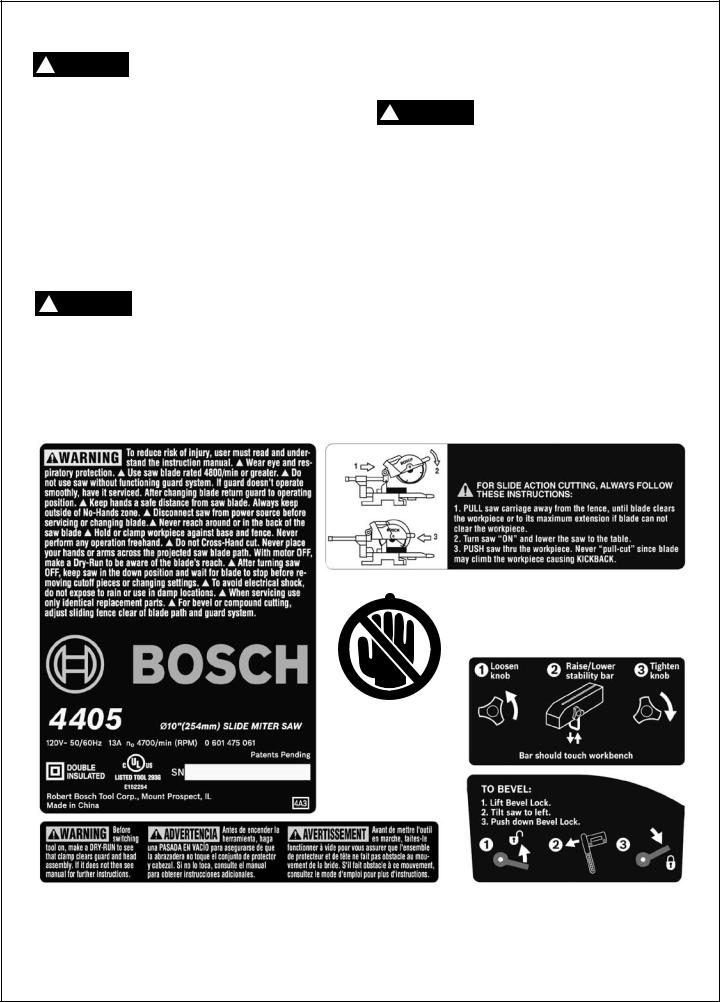
Safety
! WARNING “READ ALL INSTRUCTIONS” — Failure to follow the SAFETY RULES identified by BULLET (●) symbol listed BELOW and other safety precautions, may result in serious personal injury.
●Do not allow familiarity gained from frequent use of your miter saw to become commonplace. Always remember that a careless fraction of a second is sufficient to inflict severe injury.
●THINK SAFETY! SAFETY IS A COMBINATION OF OPERATOR’S COMMON SENSE, KNOWLEDGE OF THE SAFETY AND OPERATING INSTRUCTIONS AND ALERTNESS AT ALL TIMES WHEN THE MITER SAW IS BEING USED.
THE WARNINGS SHOWN
BELOW CAN BE FOUND ON YOUR TOOL. THESE WARNINGS ARE ONLY A CONDENSED FORM OF THE MORE DETAILED SAFETY RULES AND PRECAUTIONS THAT APPEAR IN YOUR OWNER'S MANUAL. THEY SERVE AS A REMINDER OF ALL SAFETY RULES NEEDED FOR SAFE OPERATION OF THIS MITER SAW.
! WARNING Some dust created by power sanding, sawing, grinding,
drilling, and other construction activities contains chemicals known to cause cancer, birth defects or other reproductive harm. Some examples of these chemicals are:
•Lead from lead-based paints,
•Crystalline silica from bricks and cement and other masonry products, and
•Arsenic and chromium from chemically treated lumber.
Your risk from these exposures varies, depending on how often you do this type of work. To reduce your exposure to these chemicals: work in a well ventilated area, and work with approved safety equipment, such as those dust masks that are specially designed to filter out microscopic particles.
DESIGNATED
DANGER ZONE.
AVOID POSITIONING
HANDS, FINGERS OR
ARMS IN THE AREA
DESIGNATED BY
THIS SYMBOL.
“SAVE THESE INSTRUCTIONS”
5.

Safety
! WARNING |
“READ ALL INSTRUCTIONS” — |
Failure to follow the SAFETY RULES identified by |
|
BULLET (●) symbol listed BELOW and other safety precautions, may result in serious personal injury. |
|
|
||
Double Insulated Tools |
Extension Cords |
|
Double insulation 


 is a design concept used in electric power tools which eliminates the need for the three wire grounded power cord and grounded power supply system. It is a recognized and approved system by Underwriter’s Laboratories, CSA and Federal OSHA authorities.
is a design concept used in electric power tools which eliminates the need for the three wire grounded power cord and grounded power supply system. It is a recognized and approved system by Underwriter’s Laboratories, CSA and Federal OSHA authorities.
●Servicing of a tool with double insulation requires care and knowledge of the system and should be performed only by a qualified service technician.
●WHEN SERVICING, USE ONLY IDENTICAL REPLACEMENT PARTS.
●POLARIZED PLUGS. Your tool is equipped with a polarized plug (one blade is wider than the other), this plug will fit in a polarized outlet only one way. If the plug does not fit fully in the outlet, reverse the plug. If it still does not fit, contact a qualified electrician to install the proper outlet. To reduce the risk of electrical shock, do not change the plug in any way.
●Replace damaged cords immediately. Use of damaged cords can shock, burn or electrocute.
●If an extension cord is necessary, a cord with
adequate size conductors should be used to prevent excessive voltage drop, loss of power or overheating. The table shows the correct size to use, depending on cord length and name plate amperage rating of tool. If in doubt, use the next heavier gauge. Always use U.L. and CSA listed extension cords.
RECOMMENDED SIZES OF EXTENSION CORDS
Tools |
|
120 Volt A.C. Tools |
|
|
Ampere |
|
Cord Length in Feet |
|
|
Rating |
|
Cord Size in A.W.G. |
|
|
|
|
|
|
|
|
25 |
50 |
100 |
150 |
3-6 |
|
|
|
|
18 |
16 |
16 |
14 |
|
6-8 |
18 |
16 |
14 |
12 |
8-10 |
18 |
16 |
14 |
12 |
10-12 |
16 |
16 |
14 |
12 |
12-16 |
14 |
12 |
N/A |
N/A |
|
|
|
|
|
NOTE: The smaller the gauge number, the heavier the cord.
“SAVE THESE INSTRUCTIONS”
Table of Contents
Safety . . . . . . . . . . . . . . . . . . . . . . . . . . . . . . . . . . . . . 2-6
General Safety Rules For Bench Top Tools . . . . . . . . 2
Safety Rules For Miter Saws . . . . . . . . . . . . . . . . . . 3-6
Table of Contents. . . . . . . . . . . . . . . . . . . . . . . . . . . . . . 6
Electrical Requirements . . . . . . . . . . . . . . . . . . . . . . . . 7
Getting To Know Your Miter Saw . . . . . . . . . . . . . . . 8-9
Assembly. . . . . . . . . . . . . . . . . . . . . . . . . . . . . . . . . 10-12
Tools Needed For Assembly And Alignment . . . . . . 10
Unpacking and Checking Contents . . . . . . . . . . . . . 10
Attaching Miter Lock Knob . . . . . . . . . . . . . . . . . . . . 11
Assembling Dust Elbow and Dust Bag. . . . . . . . . . . 11
Installation and Removal of the Blade . . . . . . . . . . . 12
Adjustments . . . . . . . . . . . . . . . . . . . . . . . . . . . . . . 13-16
Blade Square To Table (90°) . . . . . . . . . . . . . . . . . . . 13
Blade 45° To The Table . . . . . . . . . . . . . . . . . . . . . . . 14
Blade 33.9º To The Table . . . . . . . . . . . . . . . . . . . . . 15
Blade Square To Fence. . . . . . . . . . . . . . . . . . . . . . . 16
Miter Scale Indicator Adjustment . . . . . . . . . . . . . . . 16
Installation. . . . . . . . . . . . . . . . . . . . . . . . . . . . . . . . 17-18
Mounting Applications . . . . . . . . . . . . . . . . . . . . . . . 17
Portable Mounting Using Clamps. . . . . . . . . . . . . . . 18
Stability Bar Adjustment . . . . . . . . . . . . . . . . . . . . . . 18
Basic Saw Operations . . . . . . . . . . . . . . . . . . . . . . 19-22
Body and Hand Position . . . . . . . . . . . . . . . . . . . . . . 19
Workpiece Support . . . . . . . . . . . . . . . . . . . . . . . . . . 20
Auxilliary Fence . . . . . . . . . . . . . . . . . . . . . . . . . . . . . 21
Switch Activation. . . . . . . . . . . . . . . . . . . . . . . . . . . . 21
Detent Override . . . . . . . . . . . . . . . . . . . . . . . . . . . . . 22
Sliding Base/Fence Extension . . . . . . . . . . . . . . . 22-23
Saw Operations . . . . . . . . . . . . . . . . . . . . . . . . . . . 24-31
Chop Cut. . . . . . . . . . . . . . . . . . . . . . . . . . . . . . . . . . 24
Slide Cut . . . . . . . . . . . . . . . . . . . . . . . . . . . . . . . . . . 24
Miter Cut . . . . . . . . . . . . . . . . . . . . . . . . . . . . . . . . . . 25
Bevel Cut . . . . . . . . . . . . . . . . . . . . . . . . . . . . . . . 25-26
Compound Cuts . . . . . . . . . . . . . . . . . . . . . . . . . . . . 26
Cutting Grooves (Dado Cut) . . . . . . . . . . . . . . . . . . . 27
Cutting Base Molding . . . . . . . . . . . . . . . . . . . . . . . . 28
Cutting Crown Molding . . . . . . . . . . . . . . . . . . . . 28-30
Special Cuts . . . . . . . . . . . . . . . . . . . . . . . . . . . . . . . 31
Maintenance and Lubrication. . . . . . . . . . . . . . . . . . . 32
Troubleshooting . . . . . . . . . . . . . . . . . . . . . . . . . . . 33-35
Slide Action Adjustment . . . . . . . . . . . . . . . . . . . . . . 35
Adjusting Bevel Lock Lever Tension . . . . . . . . . . . . . 35
Accessories . . . . . . . . . . . . . . . . . . . . . . . . . . . . . . . . . 36
6.

Electrical Requirements
1.Connect this saw to a 120V, 15-amp branch circuit with a 15-amp time delay fuse or circuit breaker. Using the wrong size fuse can damage the motor.
2.Fuses may “blow” or circuit breakers may trip frequently if motor is overloaded. Overloading can occur if you feed the blade into the workpiece too rapidly, start and stop too often in a
short time, or use the wrong blade for the application.
3.Most motor troubles may be traced to loose or incorrect connections, overload, low voltage (such as small size wire in the supply circuit or overly long supply circuit wire). Always check the connections, the load and the supply circuit whenever motor does not work well.
Electric Brake
Your saw is equipped with an automatic electric brake which is designed to stop the blade from spinning in about five (5) seconds after you release the trigger switch. It is useful when making certain cuts in wood where a coasting blade would result in a wide, imprecise cut.
! WARNING |
When electrical power is lost due to |
|
blown fuse or other causes, the |
|
motor will gradually slow down and the braking action is initiated ONLY by the release of the trigger switch.
The electric blade brake of your miter saw has been designed for highest degree of reliability, but unexpected circumstances such as contamination on the commutator and brushes or failure of motor’s components can cause the brake not to activate. If this condition occurs, turn the saw “ON” and “OFF” four to five times without contacting the workpiece. If the tool operates but the brake does not consistently stop the blade in about five (5) seconds, DO NOT use saw and have it serviced immediately.
The brake action of this saw is not intended as a safety feature.
Remember to let the saw blade come to a complete stop before raising the blade from the workpiece. As always the guard system is your best protection against unintentional contact with a spinning saw blade. NEVER wedge open or defeat the closing action of the lower guard.
7.
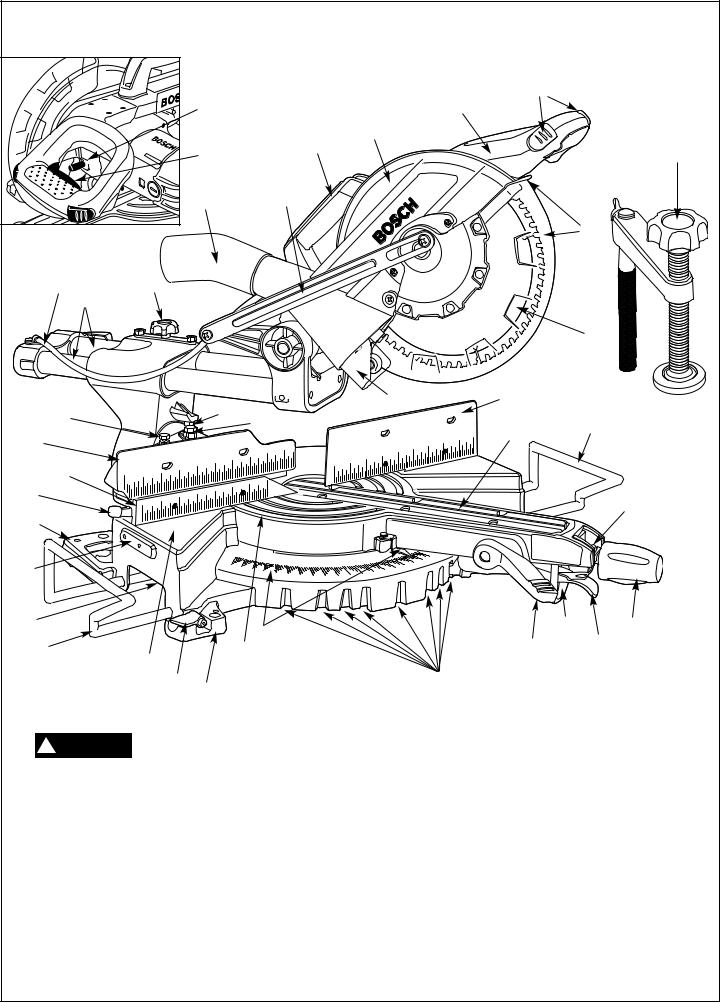
Getting To Know Your Miter Saw
|
|
1 |
|
4 |
|
3 |
|
|
|
||
|
40 |
30 |
|
2 |
28 |
||
|
|||
22 |
29 |
|
|
|
|
5 |
32 |
26 |
|
|
|
|
|
27 |
|
|
|
|
|
|
|
|
|
6 |
25 |
|
23 |
21 |
7 |
|
|
24 |
8 |
18 |
||
19 |
|
|
|
|
|
|
|
|
|
|
|
7 |
|
|
|
|
|
20 |
|
|
|
|
9 |
16 |
|
|
|
|
|
|
|
|
|
|
|
41 |
|
|
|
|
|
40 |
|
|
12 |
43 |
10 |
|
|
|
|||
18 |
|
14 |
34 |
11 |
|
15 |
|
||||
|
|
|
|
||
|
|
|
13 |
|
|
|
17 |
16 |
|
|
|
|
|
|
|
To avoid injury from accidental starting, remove plug from power
source outlet before making any adjustments.
1. Switch “Lock-OFF” Button
This button must be pressed to activate the power switch.
2. Power Switch
The power switch (used with the “Lock-OFF” button) energizes the unit.
3. Switch Handle
This handle contains the switch. The blade is lowered into the workpiece by pushing/pulling down on the handle. Never pick up tool by switch handle.
4. Arbor Lock
Allows the user to keep the blade from rotating while tightening or loosening arbor screw during blade replacement or removal.
5. Lower Blade Guard/Lower Guard Lip
The lower blade guard helps protect your hands from the spinning blade. It retracts as the blade is lowered. Guard Lip can be used to raise the lower guard manually, only as recommended in this manual.
6. Blade
Use only 10" blades between 1.4 and 3.0mm thick, with 5/8" arbor hole.
7. Stationary Fence
Supports the workpiece. The fence has a cast in scale to make repetitive cuts easy. The fence also has holes which are used to secure an auxiliary fence if desired.
8.Kerf Inserts
9.Miter Detent Override
Allows detent action to be locked out allowing for fine adjustments to any miter angle.
8.
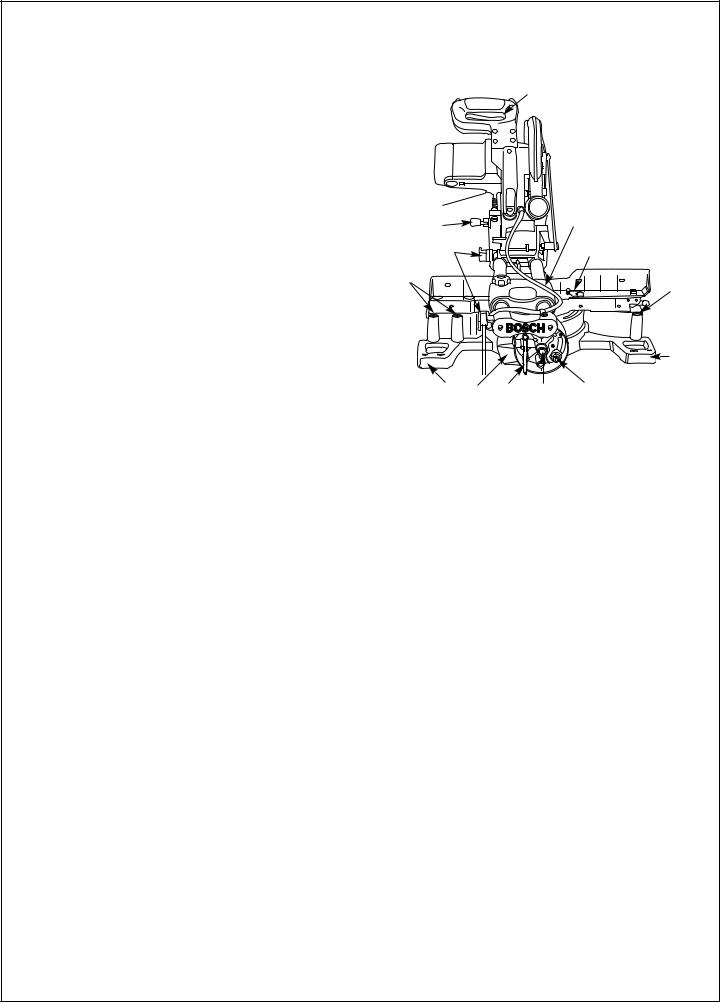
Getting To Know Your Miter Saw
10. Miter Lock Knob
The miter lock knob locks the miter saw table at any desired miter angle.
11. Miter Detent Trigger
The trigger releases the table from the detent.
12. Miter Scale/Miter Angle Indicator
Scale is cast in on the base of the saw. Indicator is fastened to the table.
13. Miter Detents
There are ten (10) miter detents for fast and accurate miter cuts of common miter angles.
14. Table
Sits in base, provides workpiece support, rotates for desired miter cuts and rotates the head assembly. The front extended part of the table is called the miter arm.
15. Base
Provides working surface to support workpiece.
16.Tool Mounting Pads
17.Base Extension Clamping Levers
Locks Base Extensions into place. One for each extension.
18. Extension Rods
Add support for long workpieces.
19. Sliding Fence
This provides extra support and clamping area for compound miter cuts.
20.Sliding Fence Clamping Lever
Locks the Sliding Fence in place.
21.Chip Deflector with Dust Flap
This protects against large chips from entering the upper guard.
22. Dust Chute Elbow
The dust chute elbow rotates 360° and can accommodate the dust bag or a vacuum hose hookup.
23. 0° Bevel Stop
Adjustable stop for a quick and accurate 0° bevel index.
24. 33.9º Bevel Stop
Adjustable stop for a quick and accurate 33.9° bevel index.
25. 45° Bevel Stop
Adjustable stop for a quick and accurate 45° bevel index.
26. Slide Rail Lock Knob
The slide rail lock knob locks the slide rails when you are not making slide cuts and when you are transporting the saw.
27. Slide Rails
Guide the head assembly when making slide cuts.
28. Workpiece Clamp
Provides fast clamping of workpiece.
29. Lower Guard Actuation Link
Allows for smooth movement of the lower guard.
30. Upper Blade Guard
Covers upper portion of the blade.
31. Blade Wrench
Used for tightening/loosening blade and adjusting fence and glide blocks. Blade wrench is stored in rear of saw.
32. Power Cord
Supplies power to motor. Has molded cord retainer for storage.
2
38




37 |
|
|
|
32 |
36 |
|
|
|
|
|
|
|
|
|
42 |
|
|
|
39 |
33 |
|
|
|
33 |
|
|
|
|
16 |
16 |
35 |
31 |
44 |
45 |
33. Workpiece Clamp Positions
There are three (3) positions behind the fence for the workpiece clamp.
34. Bevel Lock Lever
The bevel lock handle locks the head assembly at a desired bevel angle.
35. Bevel Scale
Indicator used to set bevel angles.
36. Head Assembly Lock Pin
Saw is equipped with a lock pin used to lock the head assembly in the lower position. Should be locked in the lower position during transportation.
37. Depth Stop
Allows you to adjust the depth of the blade for cutting grooves in the workpiece.
38. Brush Caps
These caps keep the motor brushes in position and provide easy access for inspecting and replacing brushes.
39.Sliding Fence Cover Plate
Rotate cover plate to remove fence.
40.Carry Handles
41.Crown Stop Bosses
Allow use of Bosch crown stops.
42. Cord Wrap
Provides location to store power cord.
43. Stability Bar
Provides support for the end of the table.
44. Pivot Bolt
Tighten/Loosen to adjust bevel tension.
45. Bevel Lock Nut
Adjusts bevel lock clamp force.
9.
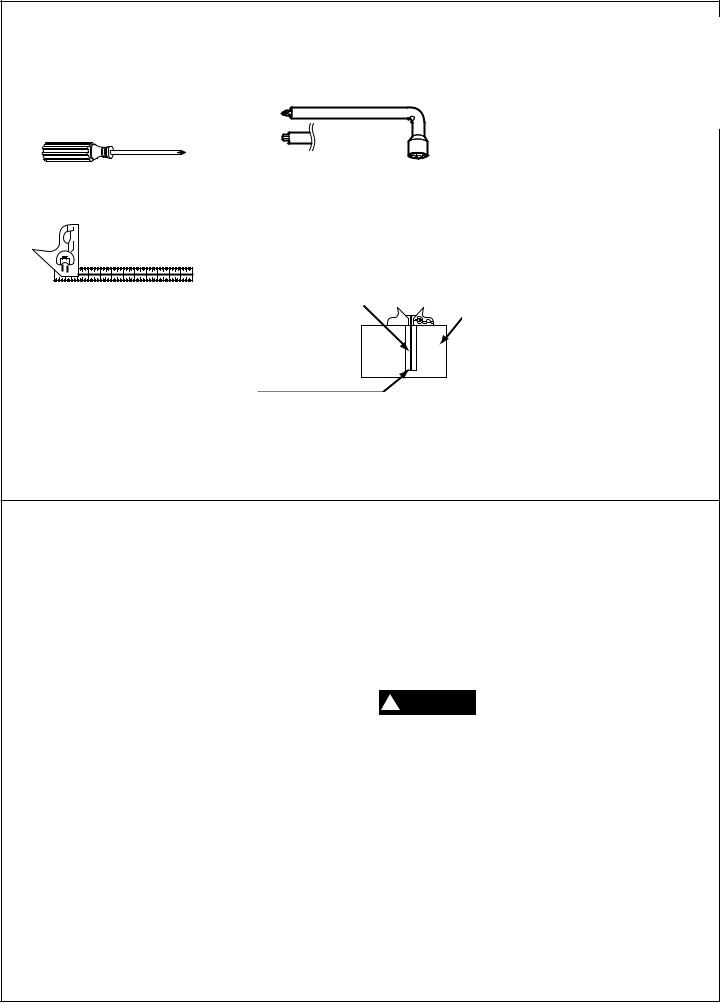
Assembly
Tools Needed For Assembly And Alignment
Phillips Screwdriver
Combination Square
Blade Wrench (supplied), hex on other side of phillips.
Combination Square Must be True
Draw Light |
Straight Edge of |
Line on Board |
Board 3/4" Thick |
Along this Edge |
This Edge Must be |
|
Perfectly Straight |
Should be no Gap or Overlap when Square is Flipped Over in Dotted Position
Disconnect plug from power source before performing any assembly, adjustment or repair to avoid possible injury.
Unpacking And Checking Contents
Model 4405 Slide Compound Miter Saw is shipped complete in one box.
1.Separate all parts from packing materials and check each one with the “Table of Loose Parts” to make sure all items are accounted for before discarding any packing material.
2.Table of Loose Parts: (See pages 8 and 9) Screw Clamp
Dust Elbow/Dust Bag Miter Lock Knob
! WARNING |
If any parts are missing, do |
not |
|
plug in power cord or turn |
the |
|
switch on until the missing parts are obtained and are installed correctly. Call 1-877-BOSCH99 to obtain missing parts.
Before moving the saw: Lock the miter lock knob in 45° position.
Lock bevel lock handle. Pull the head assembly completely toward you and tighten the slide rail lock knob. Lock head assembly in the down position.
Never carry the tool by the slide rails, this may cause blade misalignment.
Never carry the tool by the cord or head assembly power switch handle. Damage to insulation could cause an electric shock. Damage to wire connections could cause a fire.
Call 1-877-BOSCH99; if you need assistance.
10.
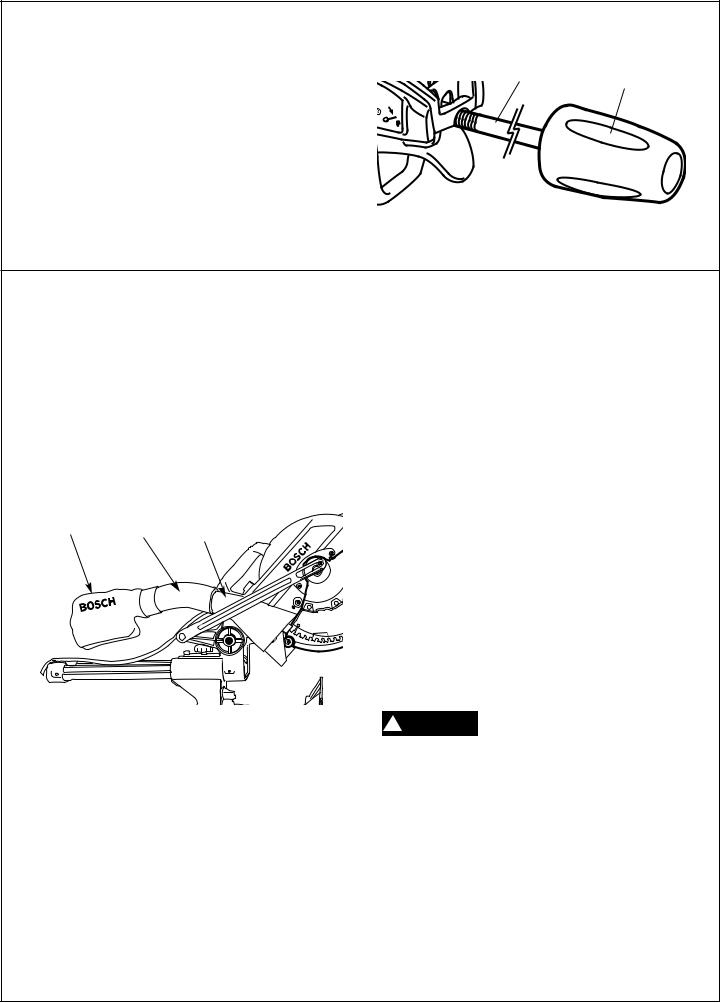
Assembly
Attaching Miter Lock Knob
Shaft |
Miter Gauge |
|
Lock Knob |
Locate the miter lock knob from among the loose parts and thread shaft into miter detent assembly as shown in Figure 4.
Figure 4: Miter Lock Knob
Assembling Dust Elbow And Dust Bag
1.Push the dust elbow onto the dust nozzle. Rotate elbow to the desired position. (Figure 5).
Dust |
Dust |
Dust |
Bag |
Elbow |
Nozzle |
Figure 5. Dust Bag and Elbow
2. The dust bag attaches to the dust chute elbow and is used to collect sawdust. The dust elbow can also be attached to a standard 2" vacuum tube for dust collection.
3. Position dust elbow/bag so that it does not interfere with the tool during the cutting operation for all miter/bevel settings. Make sure dust bag does not interfere with the slide rails during slide cutting.
4. The dust bag requires emptying when full of sawdust. Empty it frequently and after completion of sawing. Carefully remove dust bag from dust elbow. Empty dust bag in proper trash bin by unzipping the bag. Be extremely careful of disposed dust, materials in fine particle form may be explosive. Do not throw sawdust on an open fire. Over time, spontaneous combustion can result from mixing oil or water with dust particles.
When sawing chemically pressure treated lumber, paint that may be lead based, or any other materials that may contain
carcinogens, use special precautions. A suitable respirator must be worn by all personnel entering the work area. Work areas should be sealed by plastic sheeting and persons not protected should be kept out until work areas are thoroughly cleaned.
11.
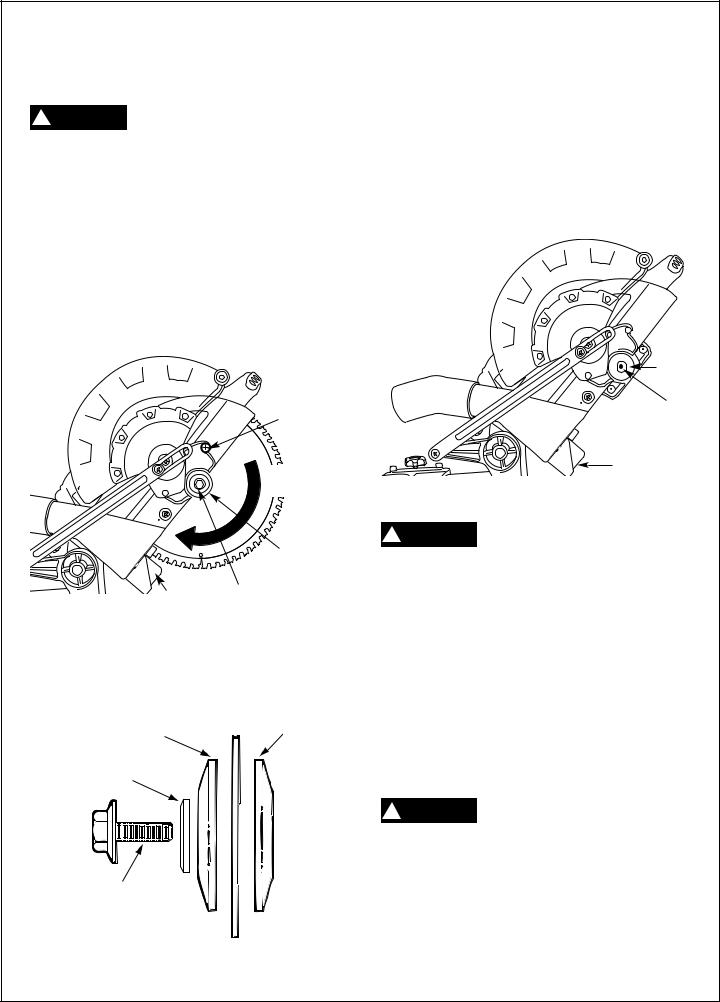
Assembly
Installation And Removal Of The Blade
Disconnect plug from power source before performing any assembly,
adjustment or repair to avoid possible injury.
1. Loosen rear cover plate screw one full turn. Do not completely remove screw.
2.Loosen front cover plate screw (approximately three full turns) until it clears the tab on the cover plate; but do not completely remove screw. Rotate coverplate counter-clockwise, exposing arbor bolt blade area.
3.Rotate the guard by hand to clear the blade. Let go of guard. Plastic will be held out of way by front screw.
4.Press and hold the arbor lock. The blade may
need |
to |
be rotated for the arbor lock to catch. |
Use |
the |
blade wrench to remove the blade bolt |
by turning wrench clockwise. NOTE: The blade bolt has a left hand thread.
 Lower Guard
Lower Guard
Front Cover
Plate Screw
Turn Bolt This
Way to Loosen
Outer
Washer
Blade Bolt
Chip (Hex Cap)
Deflector
Figure 1. Blade Removal
5.Remove the blade bolt, arbor washer, outer washer and the blade. Inner washer does not need to be removed (Figure 2).
Outer Washer |
Inner Washer |
Arbor Washer
Blade Bolt
(Left Hand Thread)
Sawblade 
Figure 2. Blade Hardware
6.To install the 10" blade, fit blade between the chip deflectors and onto arbor shaft (Figure 3). NOTE: Make sure the rotation arrow on the blade matches the clockwise rotation arrow on the lower guard.
|
Inner |
|
Washer |
|
Arbor Shaft |
|
Chip |
|
Deflector |
Figure 3. Blade Installation |
|
! WARNING |
To avoid injury, do not use a blade |
|
larger or smaller than 10" diameter |
and 5/8" arbor.
7. Replace the outer washer, arbor washer, and tighten blade bolt finger tight counter-clockwise (see Figure 2). Press the arbor lock and tighten blade bolt securely using blade wrench, but do not overtighten.
8. Rotate cover plate clockwise to original position and tighten cover plate screws.
! WARNING |
Tighten the cover plate screws. |
|
Loose cover plate screw may |
|
interfere with and hang-up lower blade guard. Never use saw without cover plate securely in place. Lower guard will not function properly.
9.Be sure the arbor lock is released so the blade turns freely.
After installing a new blade, make sure the blade does not interfere with the table insert at the 0° and 45° bevel posi-
tions. Lower the blade into the table slot and check for any contact with the base or turn table structure. If blade contacts base or table, seek authorized service at 1-877-BOSCH99.
10. Replace blade wrench in storage area on saw.
12.

Adjustments
Disconnect plug from power source before performing any assembly,
adjustment or repair to avoid possible injury.
NOTE: Your slide compound miter saw was completely adjusted at the factory. However, during shipment, slight misalignment may have occurred. Check the following settings and adjust if necessary prior to using this compound miter saw.
Blade Square (90°)
To Table
90° Blade Alignment Check
1.Rotate table to 0° position and lock in place.
2.Make sure head assembly is pushed back fully against stop and slide rail lock knob is tightened.
3.Lower head assembly. Lock in place.
4.Use a combination square to check blade squareness to table. Place the combination square on the table and press it against the blade. If the blade does not contact the full length of the square, (Figure 6) follow the alignment procedure.
Combination
Square
Table

 Blade
Blade
Figure 6. Blade Square to Table
90° Blade Alignment Adjustment
1.Loosen bevel lock handle.
2.Move the head off of the 0º stop.
3.Lower 0° stop screw and jam nut with 12mm or adjustable wrench.
4.Move the saw back to 0º stop.
5.Push square against blade (fig. 6).
6.Adjust 0° bevel stop screw with 12mm or adjustable wrench until the blade makes contact with the full length of the square. Tighten jam nut (Figure 7).


 0º Stop
0º Stop
Screw
 Jam
Jam
Nut
Figure 7. Bevel 0° Stop Screw and Jam Nut
7. Adjust bevel indicator. Loosen screw and align indicator to the 0° mark. Tighten screw (Figure 8).
Adjust to 0º

 Bevel
Bevel
Indicator
Screw
Figure 8. Bevel Indicator
13.
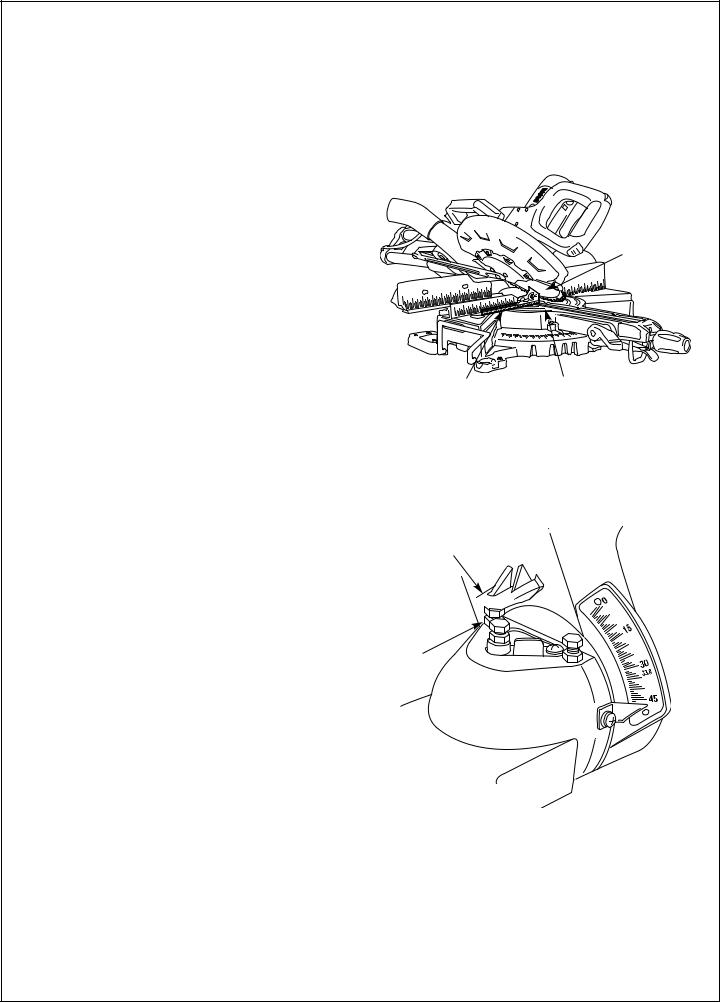
Adjustments
Blade 45° To Table
45° Blade Alignment Check
1.Rotate table to 0° position and lock in place.
2.Make sure head assembly is pushed back fully against stop and slide rail lock knob is tightened.
3.Lower head assembly. Lock in place.
4.Make sure the 33.9º bevel stop screw jam nut is in the passive position, out of line with the 90º and 45º bevel stop screw jam nuts.
5.Loosen bevel lock handle and tilt the head assembly to 45° bevel. Check the 45° bevel stop. The bevel indicator should be on the 45° mark, the 45° bevel stop should be in full contact with the 45° bevel stop screw. Place the combination square on the table and press it against the blade. The blade should contact the full length of the combination square (Figure 9).
6.If the blade is not 45° to the table, adjust 45°bevel stop.
45° Blade Alignment Adjustment
1.Lower the 45° bevel stop screw jam nut using 12mm or adjustable wrench (Figure 10).
2.Loosen bevel lock handle.
3.Lower the saw onto the 45º stop.
4.Push combination square against the blade.
5.Adjust the 45º bevel stop until the blade makes contact with the full length of the square. Tighten 45° jam nut (Figure 10).
6.Check that bevel indicator is pointing to the 45° mark on the bevel scale (see Figure 10). If bevel indicator is not aligned with the 45° mark, first recheck the blade squareness to the table and 0° bevel indicator alignment. Then, repeat the 45° blade alignment and make appropriate adjustments.
Blade
Combination |
Table |
Square |
|
Figure 9. Blade 45° To The Table
45º/33.9º Stop
45º Stop

Screw
Jam
Nut
Figure 10. Bevel 45° Stop Screw and Jam Nut
14.
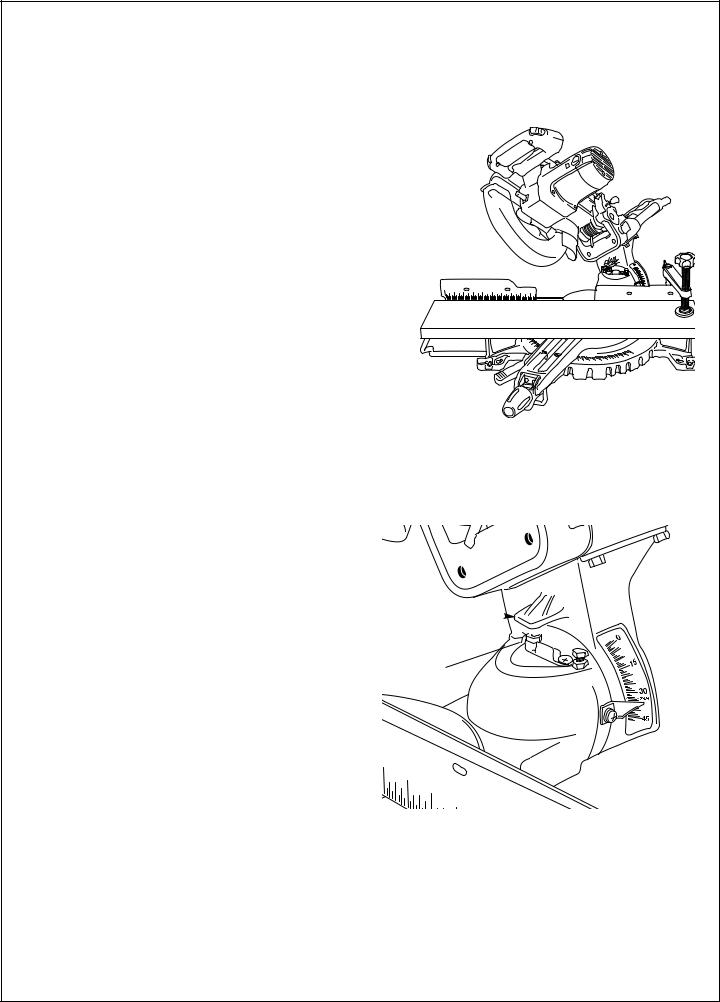
Adjustments
Blade 33.9° To Table
33.9° Blade Alignment Check
NOTE: You must check and align 45º and 90º settings first before doing 33.9º (See pages 13 and 14).
1. Rotate table to 0° position and lock in place.
2. Make sure head assembly is pushed back fully against stop and slide rail lock knob is tightened.
3. Lower head assembly. Lock in place.
4. Make sure the 33.9º bevel stop screw jam nut is in the active position, in-line with the 90º and 45º bevel stop screw jam nuts.
5. Loosen bevel lock handle and tilt the head |
|
assembly to 33.9° bevel. Check the 33.9° |
|
bevel stop. The bevel indicator should be on |
|
the 33.9° mark. |
Figure 11. Blade 33.9° To The Table |
6.If the blade is not 33.9° with the table, adjust 33.9°bevel stop.
33.9° Blade Alignment Adjustment
1.Lower the 33.9° bevel stop screw jam nut using 12mm or adjustable wrench (Figure 12).
2.Loosen bevel lock handle.
3.Lower the saw onto the 33.9º stop.
4.Adjust the 33.9º bevel stop until bevel indicator is pointing to the 33.9° mark on the bevel scale (see Figure 12). Tighten 33.9° jam nut.
45º/33.9º
Stop
33.9º Stop 

 Screw
Screw 


Jam Nut
Figure 12. Bevel 33.9° Stop Screw and Jam Nut
15.
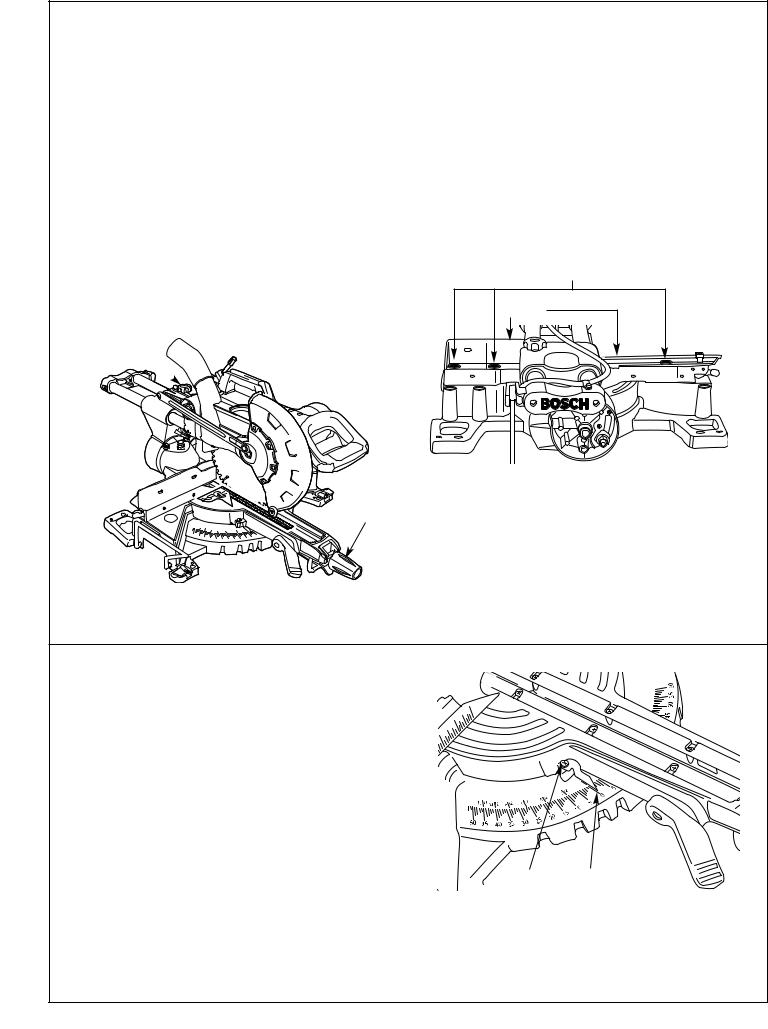
Adjustments
Blade Square to Fence
Fence Alignment Check
1.Make sure head assembly is pulled forward near the center of the table and slide rail lock knob is tightened (Figure 13).
2.Lower the head assembly, and lock in the lower position.
3.Make sure table is in 0° detent and tighten miter lock knob.
4.Place a combination square against the fence and next to the blade as illustrated. Locate the square properly so it does not contact the tooth of saw blade. The saw blade should contact the full length of the square (Figure 13).
5.If blade does not contact the square, follow the fence alignment procedure.
Slide Rail
Lock Knob
Miter Lock
Knob
Figure 13. Blade Square to Fence
Fence Alignment Adjustment
1.The head assembly should remain in lowered position.
2.Extend sliding fence. Use blade wrench (supplied) and loosen three (3) bolts behind fence (Figure 14).
3.Adjust fence until blade and the fence has full contact with the square.
4.Tighten hex cap screws.
Hex Cap Screws
Fence
Slide Rail Unit
Figure 14. Fence Adjustment (Back view of table/base area)
Miter Scale
Indicator Adjustment
1.Rotate table to 0° position and lock in place.
2.Raise the head assembly to the full-up position.
3.Loosen the Phillips screw that holds the indicator in place (Figure 15).
4.Position the indicator to align with the 0° miter mark. Tighten the screw.
 Indicator 0º Mark
Indicator 0º Mark
Screw
Figure 15.
16.
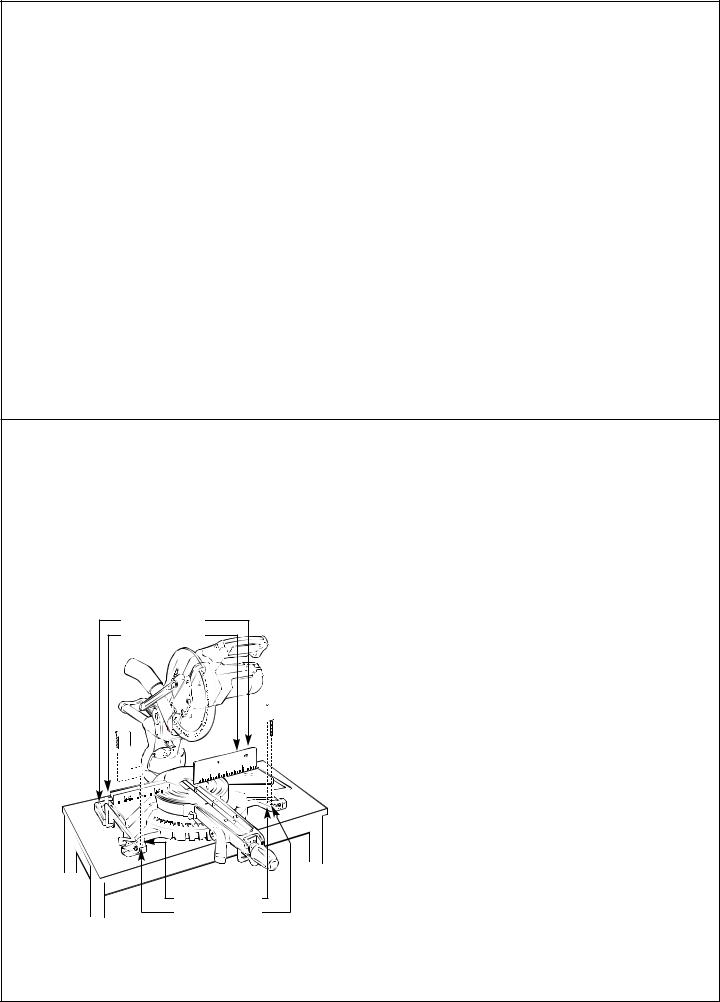
Installation
! WARNING |
To avoid injury always observe |
|
the following: |
|
●Unplug electric cord. Before transporting the saw, rotate head assembly to 45° right miter, lock into detent, pull the head assembly completely forward toward you, tighten the slide rail lock knob and lock the head assembly in the lowered position.
●To avoid back injury, hold the tool close to your body when lifting. Bend your knees so you can lift with your legs, not your back. Lift by using the cast-in carry handles at each side of the bottom of the base or the carry handle.
●Never carry the tool by the slide rails, this may cause blade misalignment.
●Never carry the miter saw by the power cord or the operational handle. Attempting to lift or carry the tool by the power cord will damage the insulation and the wire connections resulting in electric shock or fire.
●Observe the position of the saw. People standing behind it could be injured by thrown debris.
●Place the saw on a firm, level surface where there is plenty of room for handling and properly supporting the workpiece.
●Bolt, screw, nail or clamp the saw to its support surface.
! CAUTION |
Be careful not to over drive nail |
|
or over torque the bolt when |
|
attaching to support surface. This could crack foot or damage base.
Mounting Applications
Workbench
Mount the saw using either the four bolt holes (7/16") or the four screw holes (1/4”) to the workbench (Figure 16). Check for clearance to the left and right of the saw.
Bolt Holes
Screw Holes
Screw Holes
Bolt Holes
Figure 16. Workbench Mounting
1.Each of the four mounting holes should be bolted securely using 3/8" bolts, lock washers, and hex nuts (not included).
2.Locate and mark where the saw is to be mounted.
3.Drill four (4) 3/8" diameter holes through workbench.
4.Place the slide compound miter saw on the workbench aligning holes in base with holes drilled in workbench. Install bolts, lock washers and hex nuts.
Supporting surface where saw is to be mounted should be examined carefully after mounting to ensure that no movement can occur during use. If any tipping or walking of the saw is noted, check your mounting to the workbench or stand, and make necessary adjustments before operating the slide compound miter saw (see Stability Bar Adjustment on page 18).
17.
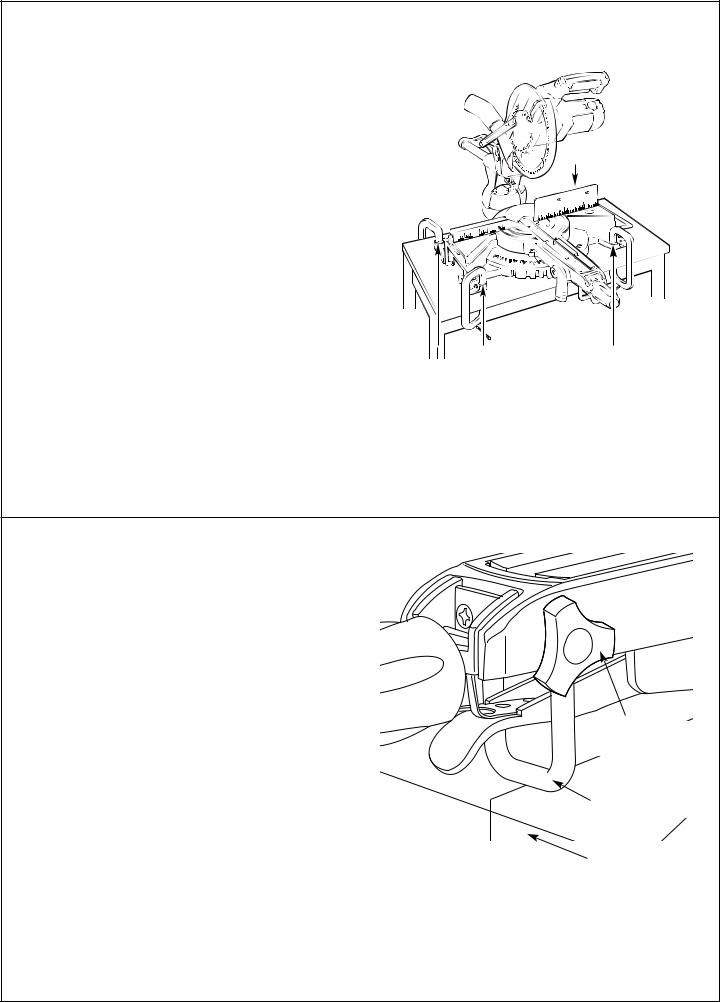
Installation
Portable Mounting Using Clamps
•If using bolts or screws is not possible, clamp the slide compound miter saw to a workbench or table top using clamps.
Clamping Area
• Place a “C” clamp on each of the clamping areas and secure (Figure 17).
Note: Use of clamps will limit use of extreme miter angles.
 Clamping Area
Clamping Area 
Figure 17. Portable Mounting Using Clamps
Stability Bar Adjustment
For added support of the table during cutting, the stability bar should be adjusted before use.
1.Loosen the knob for the stability bar.
2.Slide the stability bar up or down until it contacts the workbench.
Note: If the workbench surface is not flat, the stability bar may require readjustment at different miter angles.
3. Tighten the knob.
Stability Bar
Adjustment Knob
Stability Bar
Workbench
18.
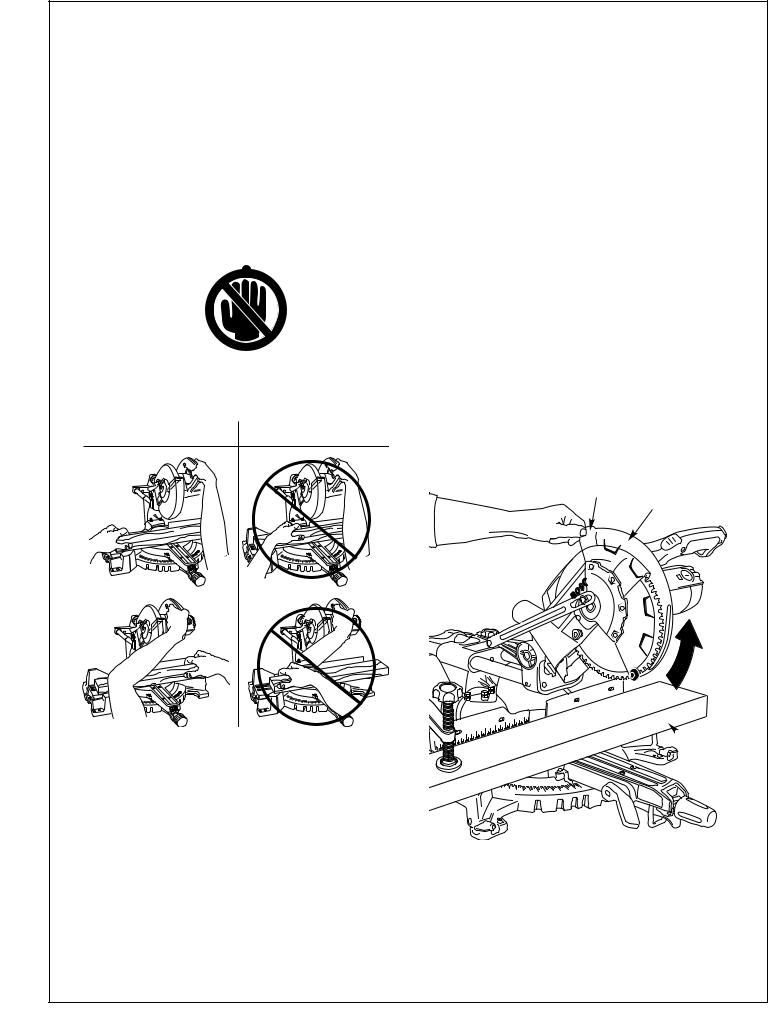
Basic Saw Operations
Body and Hand Position
! WARNING |
Position your body and hands prop- |
|
erly to make cutting easier and |
|
safer. Observe the following instructions (Figure 18).
●Never place hands near cutting area. Keep hands outside the “No Hands” zone.
●The “No Hands Zone” is defined as the entire Table and fixed portions of the base and portions of the fence within this boundary. This zone is labeled by “No Hands” symbols placed on the Base.
●Hold workpiece (outside of the “No Hands” zone) firmly to the fence to prevent movement (Fig 18).
Correct |
Incorrect Use |
||||||||
|
|
|
|
|
|
BOSCH |
|
|
BOSCH |
50 |
|
|
|
|
|
|
|
|
|
45 |
40 |
35 |
|
|
|
|
|
|
|
|
|
30 |
25 |
20 |
15 |
|
|
|
|
|
|
|
|
10 |
5 |
5 |
|||
Figure 18. Hand Positions
●Keep hands in position until trigger has been released and blade has stopped completely.
●Never place hands on slide rails.
●Keep feet firmly on the floor and maintain proper balance.
●Follow the miter arm when mitering left or right.
Stand slightly to the side of the saw blade.
●Before making any cut, with the power off, lower the blade to preview the blade path.
|
! WARNING |
The lower guard may not automati- |
|
|
|
cally open under certain cutting |
|
conditions. |
|||
|
|||
●Typically this may occur when trying to cut workpieces that are near the maximum cutting height capacity (3.5”), or when making extreme bevel cuts at maximum cutting height capacity. Under these conditions, the workpiece can stop the lower guard movement before the downward motion of the arm could pre-open the lower guard. If this occurs:
1.Workpiece must be securely clamped. This frees a hand to raise the guard by the lip just enough to clear the workpiece (Figure 19).
2.Start the saw and begin your cut.
3.Once you have cleared the position where the lower guard may bind, release the guard and it will continue to operate automatically as you cut.
Lip
Lower Guard
Open
 Workpiece
Workpiece
Figure 19. Raising Lower Guard
19.
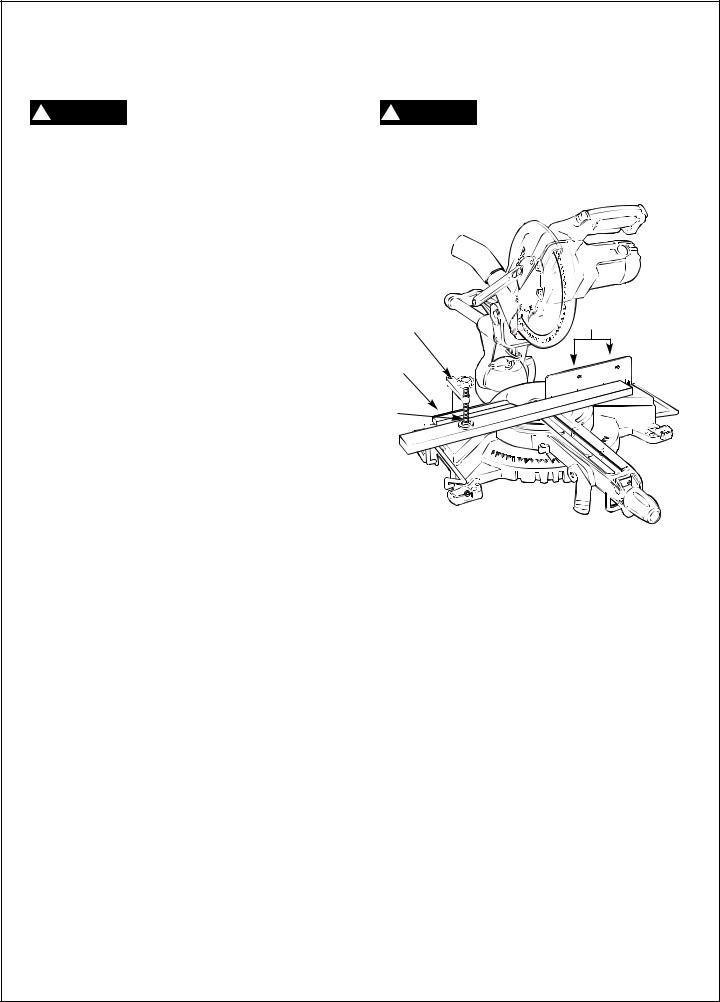
Basic Saw Operations
Workpiece Support
Long workpieces have a tendency to tip over unless clamped down
and properly supported from underneath.
Clamps
Workpiece Clamp - This clamp easily secures a workpiece in any of three (3) clamp holes behind the fence (Figure 20).
•Insert clamp post into clamp hole.
•Loosen wing nut and adjust arm to proper height, and securely tighten wing nut.
•Rotate screw knob of the clamp clockwise to tighten, counter-clockwise to loosen.
•Move the head assembly to check clearance with clamp.
There may be extreme compound cuts where clamp cannot be used.
Support workpiece with hand outside No Hands Zone. Do not try to cut short pieces that cannot be clamped and cause your hand to be in the No Hands Zone.
Clamp
Workpiece Holes
Clamp
Clamp
Hole
Screw
Rod
Figure 20. Workpiece Clamp
Conventional Clamps and other hold down devices can be used to hold the workpiece firmly against the table and the fence.
20.
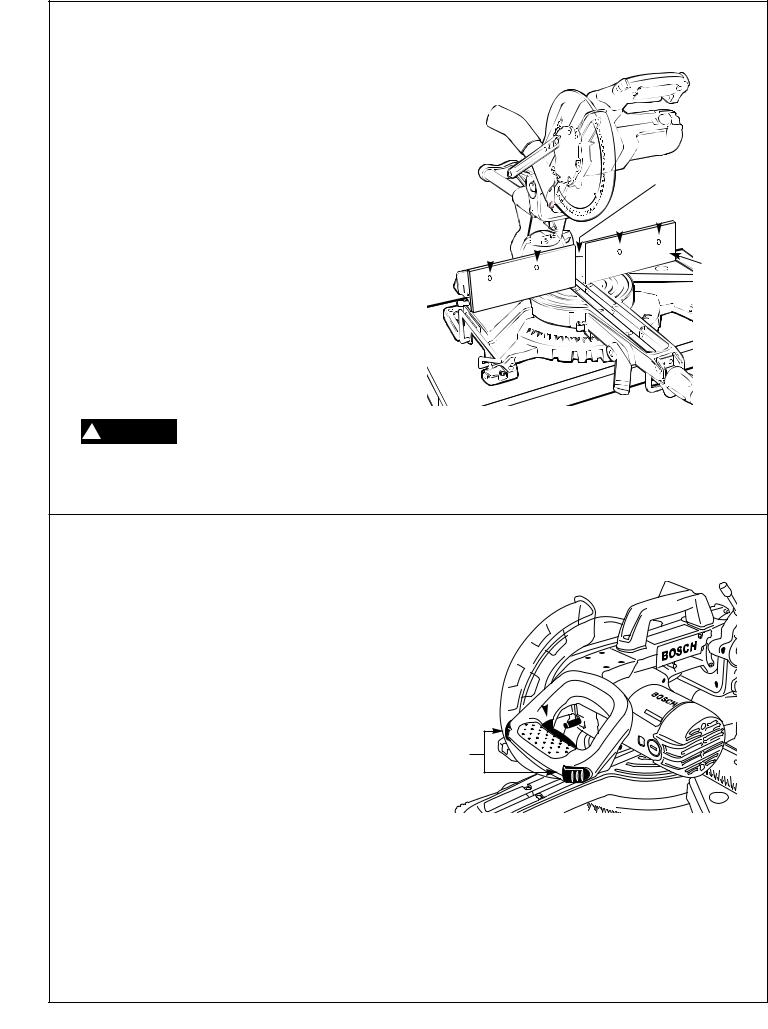
Basic Saw Operations
Auxiliary Fence - Certain types of molding need a fence face extension because of the size and position of the workpiece. Dado cuts also require an auxiliary fence. Holes are provided in the fence to attach an auxiliary fence. The auxiliary fence is used with the saw in the 0° bevel position only.
1. Place a piece of wood against the miter saw fence (Figure 21). (Wood can have a maximum height of 3-1/2". Check that head assembly does not interfere with auxiliary fence.)
2. Mark the locations of the support holes on the wood from the back side of the fence.
3. Drill and countersink the holes on the front of the support board.
4. Attach the auxiliary fence using two at least (2) 1/4" flat head machine screws per side. Make a full depth cut to create the blade slot. Check for interference between the auxiliary fence and the lower blade guard. Make adjustments as necessary.
! WARNING Check for interference from any components.
|
|
|
|
|
|
|
|
|
Blade |
Slot |
|
Flat Head |
|
|
|
|
|
|
Flat Head |
||||
|
|
|
|
|
|
||||||
Machine |
|
|
|
|
|
|
|
|
|
Machine |
|
Screws |
|
|
|
|
|
|
|
|
Screws |
||
|
|
|
|
|
|
|
|
|
|
|
Auxiliary |
|
|
|
|
|
|
|
|
|
|
||
|
|
|
|
|
|
|
|
|
|
||
|
|
|
|
|
|
|
|
|
|
|
Fence |
|
|
|
|
|
|
|
|
|
|
|
|
|
|
|
|
|
|
|
|
|
|
|
|
|
|
|
|
|
|
|
|
|
|
|
|
|
|
|
|
|
|
|
|
|
|
|
|
|
|
|
|
|
|
|
|
|
|
|
|
Figure 21. Auxiliary Fence
Switch Activation
For safety, the switch lever is designed to prevent accidental starts. To operate safety switch, press the switch “Lock-OFF” button with either thumb to disengage the lock, then pull the power switch lever and release the switch “Lock-OFF” release button. When the power switch lever is released, the switch “Lock-OFF” button will engage the safety switch automatically, and the lever will no longer operate until either “Lock-Off” button is pressed again.
NOTE: Switch lever can accommodate a padlock with a long shackle of up to 1/4" in diameter (not supplied) to prevent unauthorized use.
Power
Switch Lever
Switch “Lock-Off” Release Buttons
Figure 22. Switch Activation
21.

Basic Saw Operations
Detent Override
To Engage:
1.Lift the miter detent trigger.
2.Push the detent override clip forward and latch in place over edge. Release miter detent trigger (Figure 23).
3.Move miter arm to any position on the miter scale.
4.Lock the miter lock knob to retain miter position.
Clip Edge
Detent
Override Clip
To Disengage:
1
5. Loosen miter lock knob and lift the miter detent trigger to release the detent override clip. The
clip should automatically disengage and the
Table
table should lock into any desired miter detent.
Miter Detent
Trigger
Miter Lock
Knob
Figure 23. Detent Override
Base Extensions
! WARNING |
So as to provide sufficient (mini- |
|
mum 6”) spacing from hand to |
|
saw blade, extend the sliding fences and base extensions when making extreme bevel, miter or compound cuts.
The base extensions can also be used to provide extra support for long workpieces.
Adjusting the Extensions:
1.Loosen the base extension clamping levers.
2.Extend sliding base extensions to the desired position.
3.Press the levers down to clamp the extensions into place.
If the clamping force of the Base Extension Clamping Levers needs to be adjusted, simply pull the red tab outward and rotate it toward the center of the saw. Let the red tab spring back into a new groove. When the red tabs are rotated down to clamp the rods, they will grip the rods with greater force.
Base
Extension
Base Extension
Clamping lever
Figure 24: Base Extensions
22.
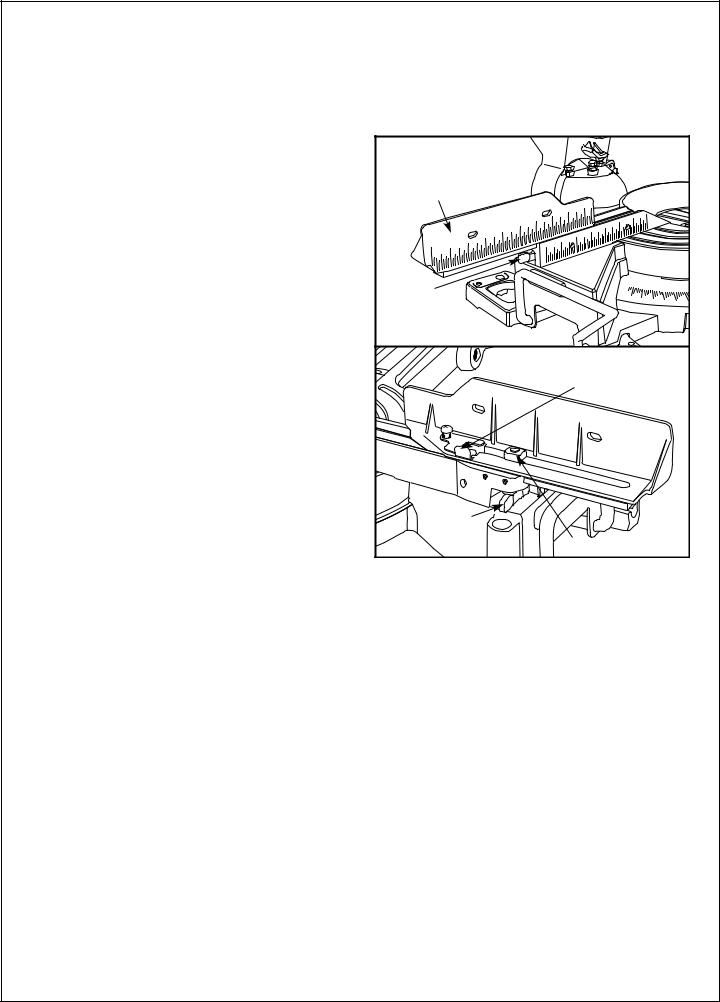
Basic Saw Operations
Sliding Fence
Sliding Fence
Operating Sliding Fence
1.Turn the fence lever counter clockwise.
2.Slide the fence to the desired position.
3.Turn the fence lever clockwise to tighten.
Removing the Sliding Fence
1.Lift up on the cover plate tab and rotate clockwise.
2.Turn the fence lever counter clockwise.
3.Slide the fence as far as it will go to the left.
4.Lift up on the sliding fence to remove.
Adjusting the Sliding Fence
Lock - Make lock tighter
1.Remove the sliding fence.
2.Push down on the locking block to expose the screw head.
3.Turn the screw counter clockwise to move it to the next hex setting.
4.Replace the sliding fence
5.Check the clamping force in several positions.
Be sure the lever does not block the clamp hole.
Adjusting the Sliding Fence
Lock - Make lock looser
1.Remove the sliding fence.
2.Push down on the locking block to expose the screw head.
3.Turn the screw clockwise to move it to the next hex setting.
4.Replace the sliding fence
5.Check the clamping force in several positions.
Be sure the lever does not block the clamp hole.
FRONT VIEW |
Sliding Fence |
Fence |
Lever |
REAR VIEW |
Cover Plate Tab |
Fence |
Lever |
Locking Block |
Figure 25: Sliding Fence
23.
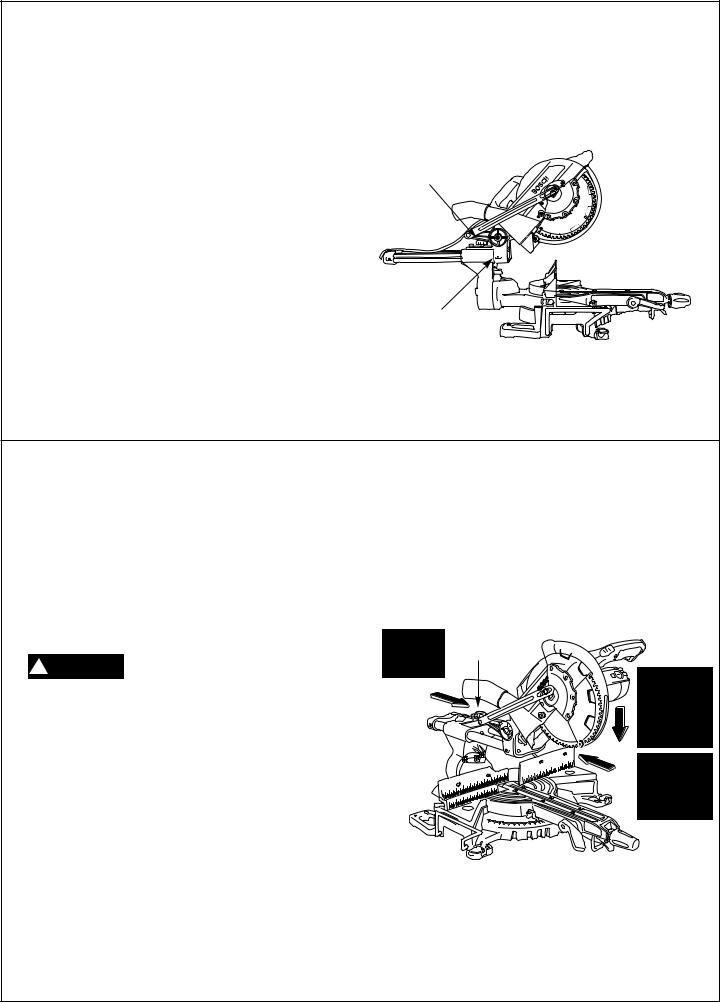
Saw Operations
Chop Cut
•During a chop cut, the slide rail lock knob is tightened and the head assembly is lowered to cut through the workpiece.
•This type of cut is used mainly for narrow pieces.
Follow these instructions for making your chop cut:
1.Slide the head assembly to the rear as far as it will go (Figure 26).
2.Tighten the slide rail lock knob (Figure 26).
3.Properly position workpiece. Make sure workpiece is clamped firmly against the table and the fence.
! WARNING |
Use clamping position that does not |
|
interfere with operation. Before |
|
switching on, lower head assembly to make sure clamp clears guard and head assembly.
4.Activate the switch. Lower the head assembly and make your cut.
5.Wait until blade comes to a complete stop before returning head assembly to the raised position and/or removing workpiece.
Slide Lock
Knob Tightened
Slide Completely
Against Rest
Figure 26. Chop Cut
Slide Cut
•During a slide cut, the slide rail lock knob is loose, the head assembly is pulled towards the operator, the head assembly is lowered to the workpiece and then pushed to the rear of the saw to make the cut.
•This type of cut is used mainly for wide pieces.
•A positive blade hook of 10 degrees or more is recommended for best performance when making aggressive cuts or cutting thicker materials. See page 36 for accessory blade listing.
NEVER pull the saw toward you during a cut. The blade can suddenly climb
up on top of the workpiece and force itself toward you.
Follow these instructions for making your slide cut:
1.Properly position workpiece. Make sure workpiece is clamped firmly against the table and the fence.
! WARNING |
Use clamping position that does not |
|
interfere with operation. Before |
|
switching on, lower head assembly to make sure clamp clears guard and head assembly.
2.Loosen the slide rail lock knob (figure 27).
3.Grasp the switch handle and pull the head assembly away from the fence, until the blade clears the workpiece or to its maximum extension if blade cannot clear the workpiece (Figure 27).
4.Activate the switch. Lower the assembly all the way down and cut through the edge of the workpiece.
5.Push (but do not force) the head assembly towards the fence to the full rear position to complete the cut.
6.Wait until blade comes to a complete stop before returning head assembly to the raised position and/or removing workpiece.
First: |
Slide Rail |
Pull |
Lock Knob |
Forward |
Second: |
|
|
|
Turn Saw |
|
On, Lower |
|
Head |
|
Assembly |
|
Third: |
|
Push |
|
Blade Into |
|
Workpiece |
Figure 27. Slide Cut
24.
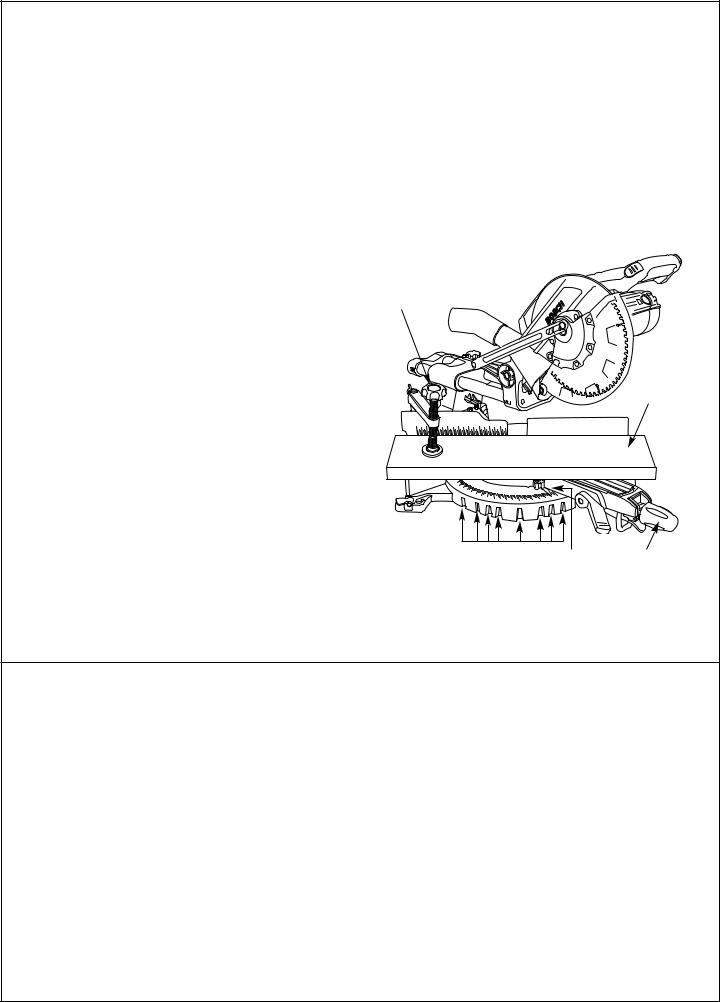
Saw Operations
Miter Cut
•A miter cut is made at 0° bevel and any miter angle in the range from 50° left to 60° right.
•The miter scale is cast-in on the table for easy reading.
•Positive detents have been provided for fast and accurate mitering at 0°, 15°, 22.5°, and 45° left and right and 60° right.
•There are crown molding detents (left and right) at 31.6° (see Cutting Crown Molding for more information page 28).
•For off detent settings, use the detent override to lock out the detent.
•A miter cut can be made as either a chop cut or a slide cut depending on the width of the workpiece.
Follow these instructions for making your miter cut:
1.Loosen miter lock knob. Lift miter detent trigger and move the saw to the desired angle, using either the detents or the miter scale. Tighten miter lock knob (Figure 28).
2.Properly position workpiece. Make sure work piece is clamped firmly against the table and the fence.
! WARNING |
Use clamping position that does |
|
not interfere with operation. Before |
|
switching on, lower head assembly to make sure clamp clears guard and head assembly.
3.Follow procedures for either chop cut or slide cut (see page 24).
4.Wait until blade comes to a complete stop before returning head assembly to the raised position and/or removing workpiece.
Workpiece
Clamp
Workpiece
Detents Miter Scale Miter Lock
Knob
Figure 28. Miter Cut
Bevel Cut |
• There is a positive crown molding bevel stop at |
|
33.9°. Disengage this stop unless using. (See |
||
• A bevel cut is made at 0° miter and any bevel |
||
Cutting Crown Molding for details.) |
||
angle in the range of 0° to 45°. |
|
|
• There are factory set bevel stops at 0° and 45°. (See |
• A bevel cut can be made as either a chop cut or |
|
a slide cut depending on the width of the work- |
||
Adjustment section if adjustments are required.) |
piece. |
|
• The bevel scale faces the operator for easy reading. |
• Use sliding fence and work supports as appropri- |
|
|
ate. (See Sliding Base/Fence Extension page 23.) |
|
|
|
|
|
25. |
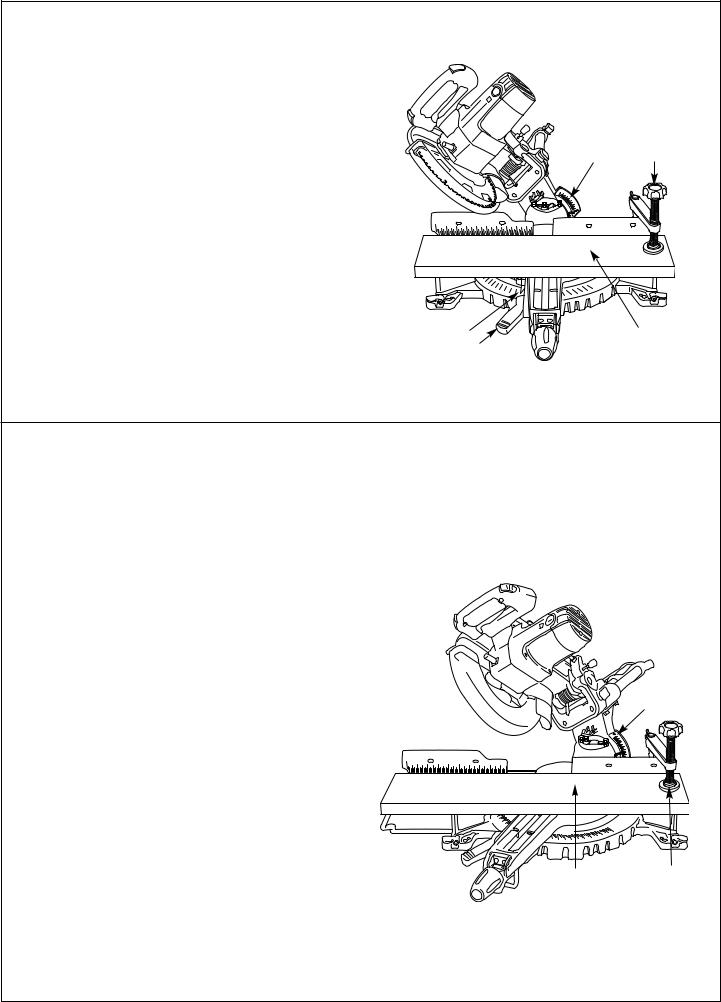
Saw Operations
Bevel Cut (Continued from page 25)
Follow these instructions for making your bevel cut:
1.To loosen, lift the bevel lock lever. Tilt the head assembly to desired bevel angle. Tighten the bevel lock lever (Figure 29).
2.Properly position workpiece. Make sure workpiece is clamped firmly against the table and the fence.
! WARNING |
Use clamping positions that do not |
|
interfere with operation. Before |
|
switching on, lower the head assembly to make sure the clamp clears the guard and head assembly.
3.Follow the procedures for either a chop cut or slide cut (see page 24).
4.Wait until blade comes to a complete stop before returning head assembly to the raised position and/or removing workpiece.
Bevel Workpiece
Angle Clamp
0º Miter |
Workpiece |
Bevel Lock Lever
Figure 29. Bevel Cut
Compound Cuts
•A compound cut is a cut requiring both a miter setting and a bevel setting.
•A compound cut can be made as either a chop cut or a slide cut depending on the width of the workpiece.
•Because it may take several tries to obtain the desired compound angle, perform test cuts on scrap material before making your cut.
Follow these instructions for making your compound cut:
1.Extend the sliding fence and work supports when making compound cuts that are mitered to the left (see Sliding Base/Fence Extension on pages 22-23). Select the desired miter and bevel angles (Figure 30). (See Miter Cut and Bevel Cut on page 25.)
2.Properly position the workpiece. Make sure the workpiece is clamped firmly against the table and the fence.
! WARNING |
Use clamping positions that do not |
|
interfere with operation. Before |
|
switching on, lower head assembly to make sure clamp clears guard and head assembly.
3.Follow the procedures for either chop cut or slide cut (see page 24).
4.Wait until blade comes to a complete stop before returning head assembly to the raised position and/or removing workpiece.
Bevel
Angle
Workpiece Workpiece
Clamp
Figure 30. Compound Cut
26.
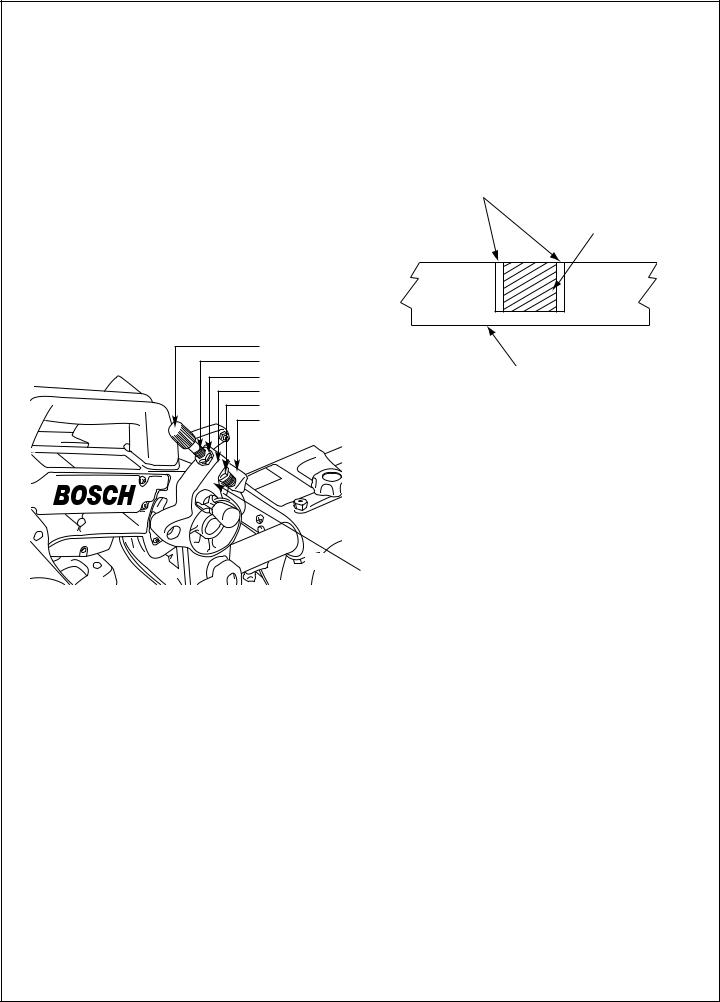
Saw Operations
Cutting Grooves
(Dado Cut)
•The depth stop adjustment is a feature used when cutting grooves (dados) in the workpiece.
•The depth adjustment is used to limit blade depth to cut grooves.
•A groove can be cut as a slide cut.
1.Set the depth of cut by loosening the jam nuts on the depth adjustment bolt (Figure 31). Do not change the position of the two (2) jam nuts on the end of the bolt.
2.Turn the depth stop bolt to the correct setting.
3.Tighten the jam nuts against the depth stop tab.
4.Cut the two outside grooves.
5.Use a wood chisel or make multiple passes by sliding the wood over to one side to remove the material between the outside grooves (Figure 32).
Grooves
Chisel Cut
Knurled Grip |
Depth Stop Bolt |
Jam Nuts |
Depth Stop Base |
Jam Nuts |
Depth Stop |
Workpiece
Figure 32. Rough Cut Groove
Depth Stop Tab
Figure 31. Cutting Grooves
Note: Auxillary fence is needed to get a constant depth. The thickness of the fence depends on the depth of the dado.
27.

Saw Operations
Cutting Base Molding
• |
3 1/2” or smaller base molding can be cut vertical |
• Cutting base molding can be done either as a |
|
against fence. All base molding can be cut flat on |
chop cut or a slide cut depending on the width of |
|
the table, up to a maximum width of 12”. |
the workpiece. |
• |
Follow the table for helpful hints on cutting |
|
|
base molding. |
|
|
|
|
BASE MOLDING CUTTING INSTRUCTIONS
SETTINGS
/
INSTRUCTIONS
Bevel Angle
Molding position
Inside |
Miter Angle |
|
corner of wall |
|
|
|
|
Molding |
|
|
position |
Left |
Right |
Finished |
|
|
|
|
|
side |
Outside |
Miter Angle |
|
corner of wall |
|
|
|
|
Molding |
|
|
position |
Left |
Right |
Finished |
|
||
|
|
|
|
|
side |
Vertical Position Back of molding is against the fence
|
0° |
|
Left Side |
|
Right Side |
|
|
|
Left at 45° |
|
Right at 45° |
|
|
|
Bottom |
|
Bottom |
against table |
|
against table |
|
|
|
Keep left |
|
Keep right |
side of cut |
|
side of cut |
|
|
|
Right at 45° |
|
Left at 45° |
|
|
|
Bottom |
|
Bottom |
against table |
|
against table |
|
|
|
Keep left |
|
Keep right |
side of cut |
|
side of cut |
|
|
|
Horizontal Position Back of molding is flat on the table
45°
Left Side |
Right Side |
0° |
0° |
|
|
Top against |
Bottom |
fence |
against fence |
|
|
Keep left |
Keep left |
side of cut |
side of cut |
|
|
0° |
0° |
|
|
Bottom against |
Top against |
fence |
fence |
|
|
Keep right |
Keep right |
side of cut |
side of cut |
|
|
Cutting Crown Molding
•Crown molding must becut exactly to fit properly.
•There are two ways to cut crown molding: flat on table or angled to table and fence.
•Your miter saw has special miter detents of 31.6° left and right and a bevel detent of 33.9° for cutting crown molding flat on the table.
•These special detents angles have been designed into your compound miter saw for the standard crown molding used in the United States with the following angles:
52° between the back of the molding and the top flat surface that fits against the wall.
38° between the back of the molding and the bottom flat surface that fits against the wall.
NOTE: These detents cannot be used with 45° crown molding.
•Even though these angles are standards, most rooms do not have angles of exactly 90°, therefore, you will need to fine tune your settings using the detent override.
•Cutting crown molding flat on the table can be done either as a chop cut or a slide cut depending on the width of the workpiece.
28.
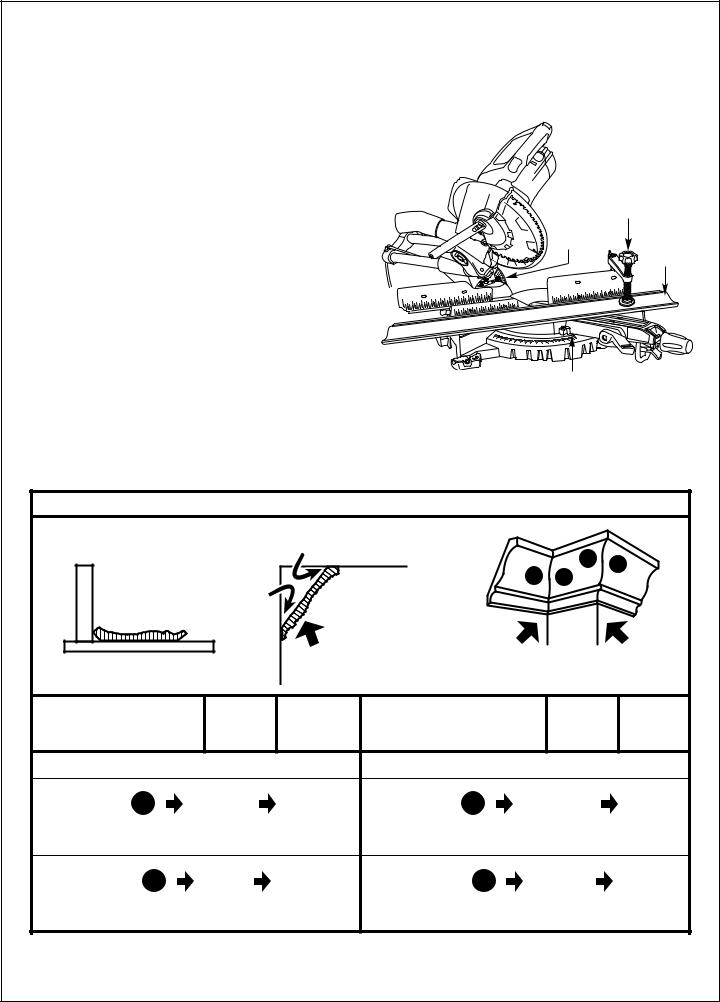
Saw Operations
Crown Molding Laying Flat on Table
Follow these instructions for cutting crown molding:
1.Set the bevel and miter angles using Chart 1 below. Tighten the miter lock knob and the bevel lock handle (Figure 33).
2.Position molding on saw table. Use the chart below for correct position. Clamp workpiece in place using the quick clamp.
NOTE: ALWAYS TAKE A TEST CUT USING SCRAP TO CONFIRM CORRECT ANGLES.
! WARNING |
Use clamping position that does not |
|
interfere with operation. Before |
|
switching on, lower head assembly to make sure clamp clears guard and head assembly.
3.Follow procedures for either chop cut or slide cut (see page 24).
4.Wait until blade comes to a complete stop before returning head assembly to the raised position and/or removing workpiece.
|
Workpiece |
|
Clamp |
33.9º |
|
Bevel |
Crown |
|
Molding |
31.6º Miter
Figure 33. Crown Molding Laying Flat
CROWN MOLDING CUTS - CUTTING METHOD #1 - FLAT ON TABLE
MAX. SIZE: 10-1/4" |
|
52º CEILING |
|
|
|
|
|
|
|
|
|
|
C |
D |
|
F |
|
|
|
A |
B |
||
|
|
|
|
||||
E |
38º |
|
|
|
|
|
|
N |
|
|
|
|
|
||
C |
W |
|
|
|
|
|
|
E |
|
|
|
|
|
||
|
A |
|
|
|
|
|
|
TABLE |
L |
ANGLES OF U.S. |
INSIDE |
OUTSIDE |
|||
L |
|||||||
|
STANDARD MOLDING |
CORNER |
CORNER |
||||
|
|
||||||
TYPE |
MITER |
BEVEL |
TYPE |
MITER |
BEVEL |
||
OF |
(TABLE) |
(TILT) |
OF |
(TABLE) |
(TILT) |
||
CUT |
SETTNING |
SETTING |
CUT |
SETTNING |
SETTING |
||
INSIDE CORNER |
|
|
OUTSIDE CORNER |
|
|
||
|
RIGHT |
|
|
|
RIGHT |
|
|
LEFT SIDE A |
31.6º |
33.9º |
LEFT SIDE |
C |
31.6º |
33.9º |
|
PLACE TOP EDGE OF |
|
|
PLACE BOTTOM EDGE OF |
|
|
||
MOLDING AGAINST FENCE - SAVE LEFT END OF CUT |
MOLDING AGAINST FENCE - SAVE RIGHT END OF CUT |
||||||
|
LEFT |
|
|
|
LEFT |
|
|
RIGHT SIDE B |
31.6º |
33.9º |
RIGHT SIDE |
D |
31.6º |
33.9º |
|
PLACE BOTTOM EDGE OF |
|
|
PLACE TOP EDGE OF |
|
|
||
MOLDING AGAINST FENCE - SAVE LEFT END OF CUT |
MOLDING AGAINST FENCE - SAVE RIGHT END OF CUT |
||||||
29.
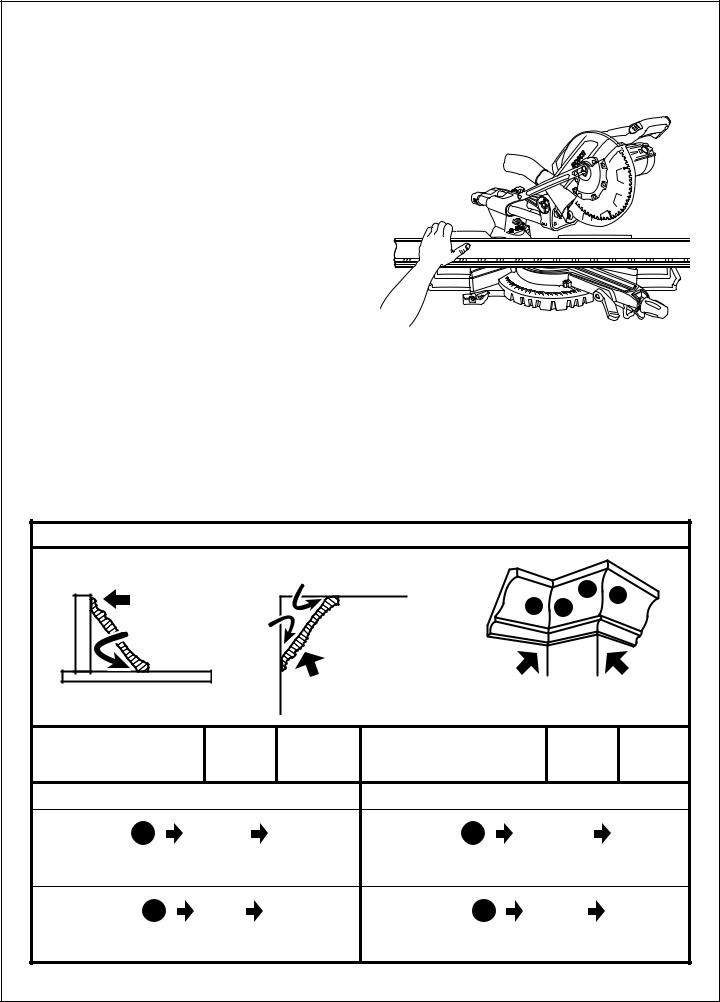
Saw Operations
Crown Molding Angled to
Table and Fence
•The advantage to cutting in this position is that no bevel setting is required. Cutting is done with 45° miter angle.
•The maximum crown molding width that can be cut and angled to table and fence is 4-1/4". The preferred method for cutting crown molding with this saw is with the molding laying flat on the table at a maximum width of 10”. Crown stops can be purchased as an accessory.
Follow these instructions for cutting crown molding angled to table and fence.
1.Position the molding so the bottom (part which is installed against the wall) is against the fence.
2.Set the miter angle using Chart 2. Tighten the miter lock knob (Figure 34).
3.Support crown molding against the fence (see “Body and Hand Position” on page 19.)
4.Follow the procedures for chop or slide cut (see page 24).
Figure 34. Crown Molding Angled to
Table and Fence
5.Wait until blade comes to a complete stop before returning head assembly to the raised position and/or removing workpiece.
NOTE: ALWAYS TAKE A TEST CUT USING SCRAP TO CONFIRM CORRECT ANGLES.
CROWN MOLDING CUTS - CUTTING METHOD #2 - ANGLED TO TABLE AND FENCE
MAX. SIZE: 4-1/4" |
|
52º CEILING |
|
|
|
|
||
|
BOTTOM EDGE |
|
|
|
C |
D |
||
F |
|
|
A |
B |
||||
|
|
|
||||||
|
|
|
|
|
||||
E |
52º |
38º |
|
|
|
|
|
|
N |
|
|
|
|
|
|||
C |
|
W |
|
|
|
|
|
|
E |
|
|
|
|
|
|
||
|
|
A |
|
|
|
|
|
|
TABLE |
L |
ANGLES OF U.S. |
INSIDE |
OUTSIDE |
||||
L |
||||||||
|
|
STANDARD MOLDING |
CORNER |
CORNER |
||||
|
|
|
||||||
TYPE |
|
MITER |
BEVEL |
TYPE |
MITER |
BEVEL |
||
OF |
|
(TABLE) |
(TILT) |
OF |
(TABLE) |
(TILT) |
||
CUT |
|
SETTNING |
SETTING |
CUT |
SETTNING |
SETTING |
||
INSIDE CORNER |
|
|
OUTSIDE CORNER |
|
|
|||
|
|
RIGHT |
|
|
|
RIGHT |
|
|
LEFT SIDE |
A |
45º |
0º |
LEFT SIDE |
C |
45º |
0º |
|
SAVE RIGHT END OF CUT |
|
|
SAVE RIGHT END OF CUT |
|
|
|||
|
|
LEFT |
|
|
|
LEFT |
|
|
RIGHT SIDE |
B |
45º |
0º |
RIGHT SIDE |
D |
45º |
0º |
|
SAVE LEFT END OF CUT |
|
|
SAVE LEFT END OF CUT |
|
|
|||
30.
